Whittled Wonders: 64 Traditional Kitchen Woodwork Ideas That Stir the Soul

How do some kitchens feel special and last through the years? Much of the warmth and lasting beauty in a room comes from the woodwork in the form of furniture, design, and stylish craftsmanship. In this piece, I will look at 64 kitchen woodwork designs that keep heritage, handcraft, and heart in mind.
With turned legs and walnut counters, these kitchen designs are more than decorations. Each one tells a story, and whether you’re updating your kitchen or designing from scratch, these pieces can become the emotional centerpiece of your space. Let’s begin with the details that matter most.
Handcrafted Wooden Kitchen Islands With Heirloom Appeal
A traditional kitchen always has a wooden island that becomes the centerpiece. An island made of smooth wood, showing clear joints and with a rich stain color can be passed through generations as a main feature in your kitchen. A kitchen gives a house personality and consistency thanks to the functions and feelings it offers.
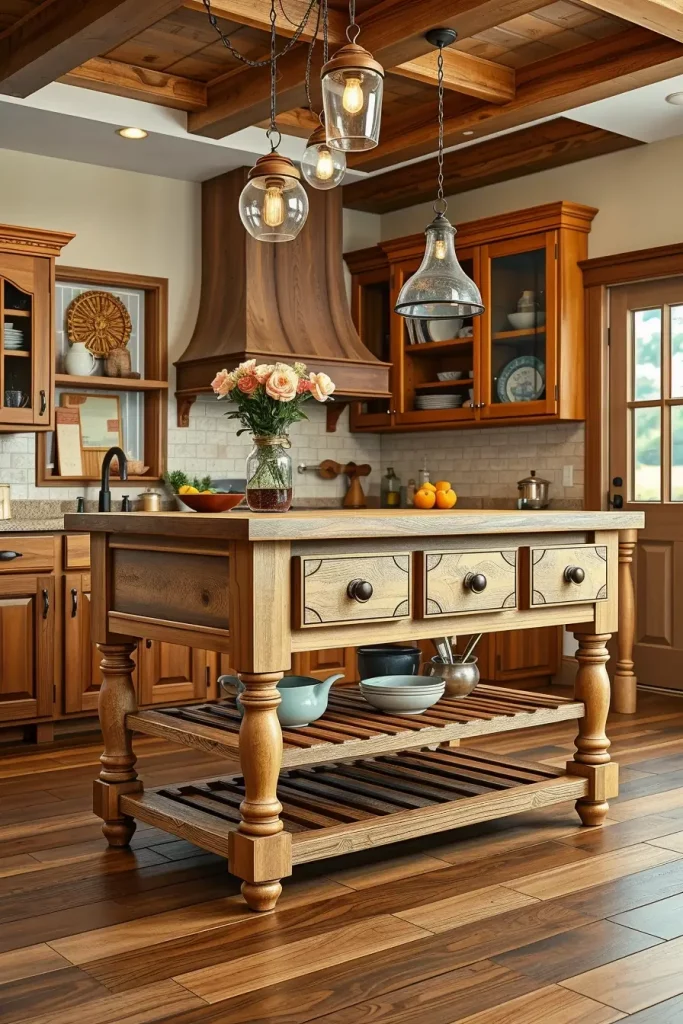
I often go for islands made of maple, cherry, or reclaimed oak and with legs or brackets around the corners. Dovetail joints on the drawers, beadboard decoration, and spacious farmhouse drawers give both an old-fashioned feel and value to any home. A butcher block or walnut countertop will bring the old look, and having the surfaces sealed with soft matte will save the look from getting wet.
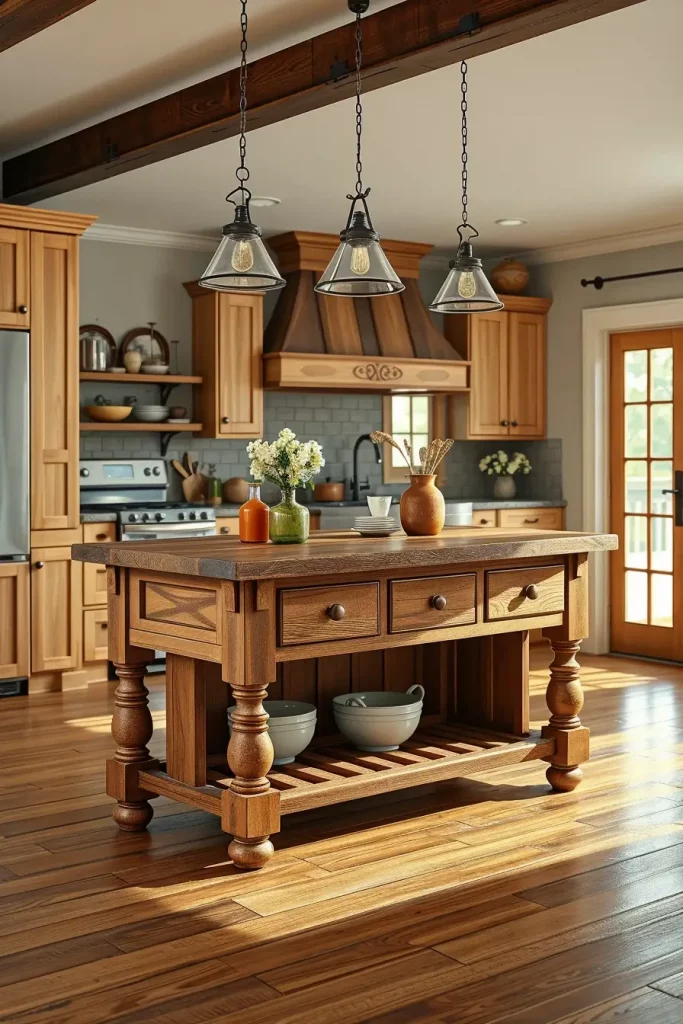
A hand-built island, in my view, tends to be the most popular section of a client’s kitchen. In the words of Architectural Digest, wooden islands with elaborate designs are likely to keep their appeal and resale price for a long time. My opinion is the same. There’s something deeply human about preparing a meal atop wood that someone shaped by hand.
Another idea is to illustrate how pendant lamps made from wrought iron or glass can contribute to the coziness of the wood. Also, putting open shelves under the island can help balance its strong appearance.
Classic Crown Molding That Frames Tradition
Classic crown molding is the most important part of traditional kitchen design. When installed with care, it forms a connection between the kitchen cabinets and the rest of the room, making everything look more elegant.
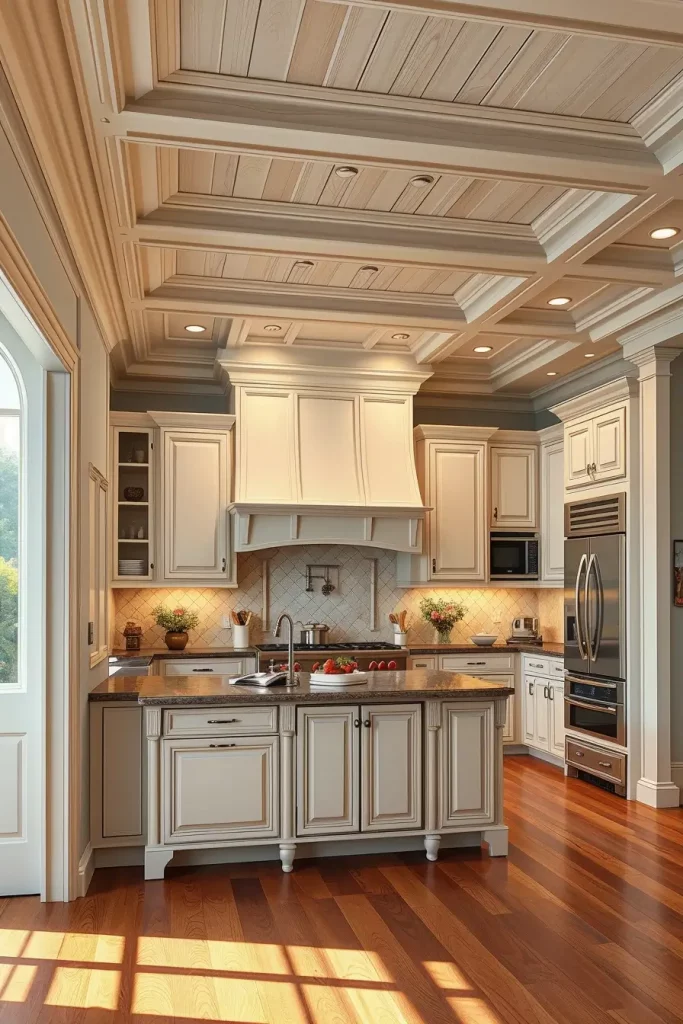
The finest use hardwood trim that is stained or painted to coordinate with the cabinets. There are variations in details in dentil molding, ogee styles, or in a stacked design, so you choose the one that best suits your style. My preference is to paint with white oak or painted ivory/soft gray because I want to see the grains of the wood through the finish.
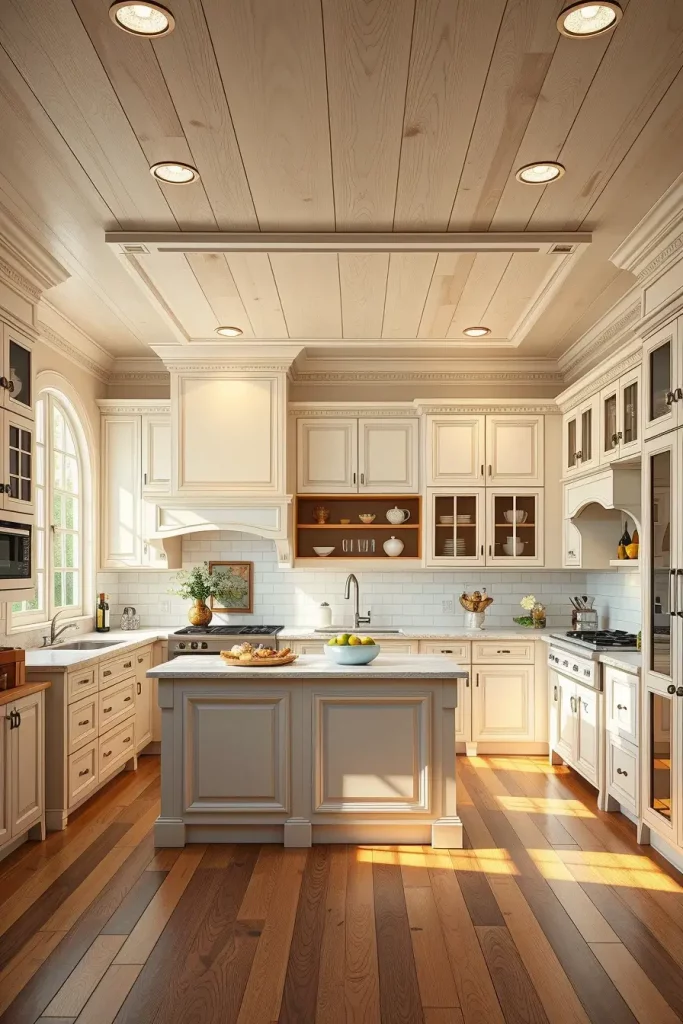
What I particularly like is that crown molding makes even simple cabinets look more elegant. As stated by Veranda Magazine, bringing in Colonial and European influences through décor adds more character to today’s interiors. Such layers is what makes a kitchen look warm and appealing for years to come.
Consider adding lighting to underneath the cabinets or on top of them to make molding details and its dark shadows stand out. It stands out in a stylish way during evening occasions.
Exposed Beam Ceilings That Tell A Timbered Tale
When I enter a kitchen with wooden beams visible, I immediately relate more to nature and the past. Overhead features in a kitchen give it character, shape, and give a sense of the home’s history, mainly if the beams are original or reclaimed.
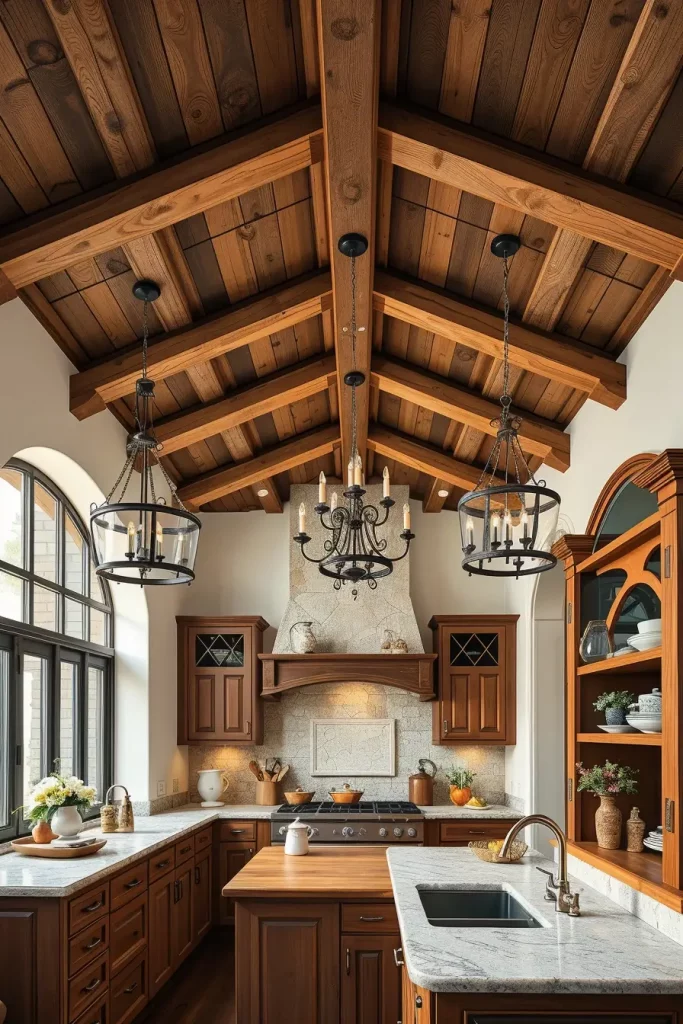
Depending on how high your ceiling is, I think rough-sawn or distressed items, such as reclaimed barn timber or hand-hewn oak, work well. With new construction, hollow beams may be stained to resemble the look of authentic wood. The main thing is to pick a beam that harmonizes with the room, and doesn’t feel too big.
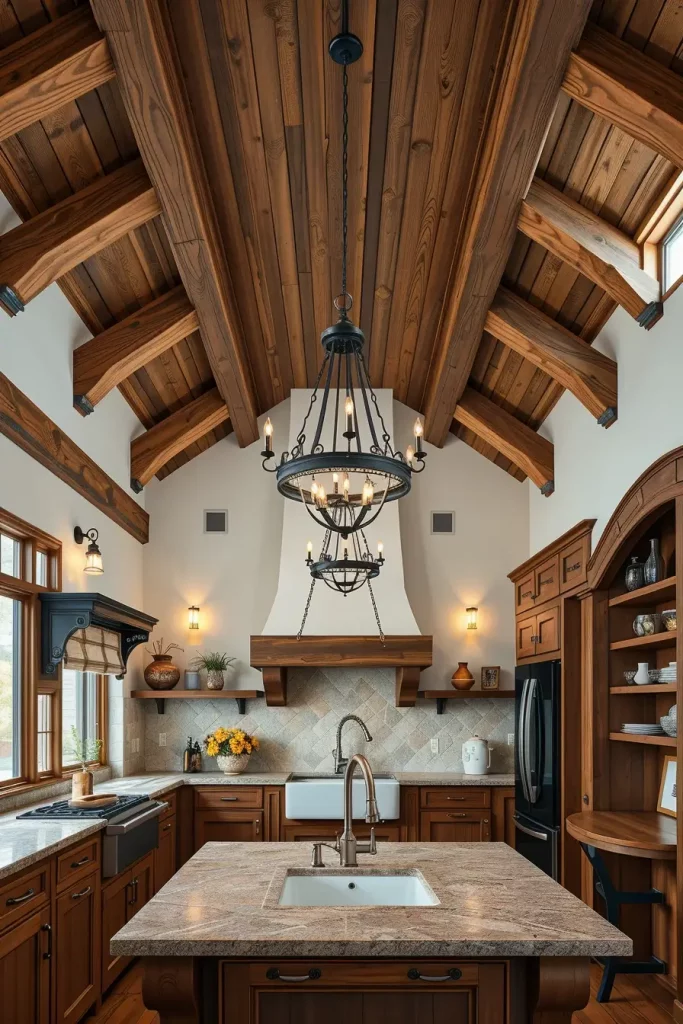
Many of my clients enjoy the look of this feature since it adds charm to the kitchen without blocking the counter. Timber beams make farmhouse and Tuscan kitchens more beautiful, and this truth is supported in many traditional renovation projects.
Another thing that can add character is hanging pendant lights or chandeliers made of wrought iron between the ceiling beams. They are used to make the room taller and blend well with the motif of the kitchen.
Turned Wood Legs For Antique-Inspired Counters
A few wood legs are enough to make a modern room look vintage. These legs and brackets used on island, countertop, or breakfast bar units look very much like unique and old furniture pieces that are rare to find in ordinary mass-produced designs.
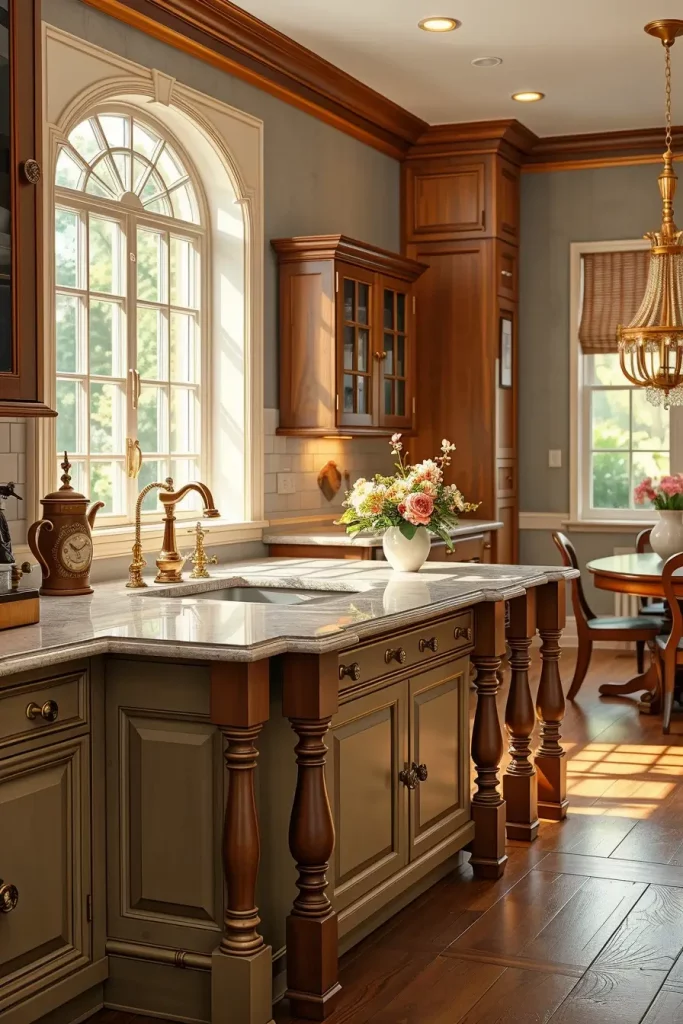
Most of the time, I select mahogany, walnut, or ash turned legs that are hand-lathed. Adding butcher block, stone, or painted surfaces makes these legs into decorative forms, making counters into legacy items. Often, I handle painting or laminating them to match the rest of the cabinetry or to stand out a little through a darker touch.

That’s one reason why This Old House makes turned legs a common feature in its farmhouse and colonial renovations. Because of their simple design and sense of grip, they fit perfectly in transitional rooms that link beauty with utility.
For this part, I advise showing how having matching leg forms in kitchen dining tables and sideboards creates harmony all around.
Carved Cabinet Corners Full Of Character
Even though cabinet corners look small, they add a lot of charm to a room. The additional aspects make the woodwork look handcrafted and recall traditions from European and American furniture over the years.
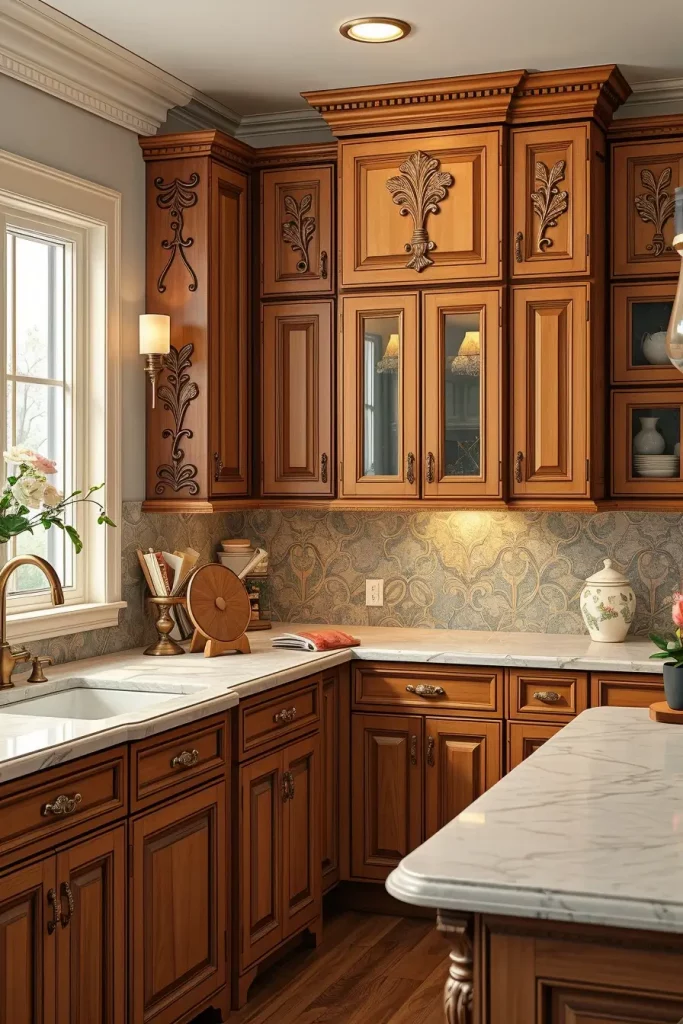
I choose to use classical scrolls, fluting, or carvings of acanthus leaves on solid cherry or maple widths. No matter if you use them in upper or lower cabinets, they make your kitchen look interesting without taking over. Putting brass or antique pewter handles on the cabinets helps the kitchen stay vintage.
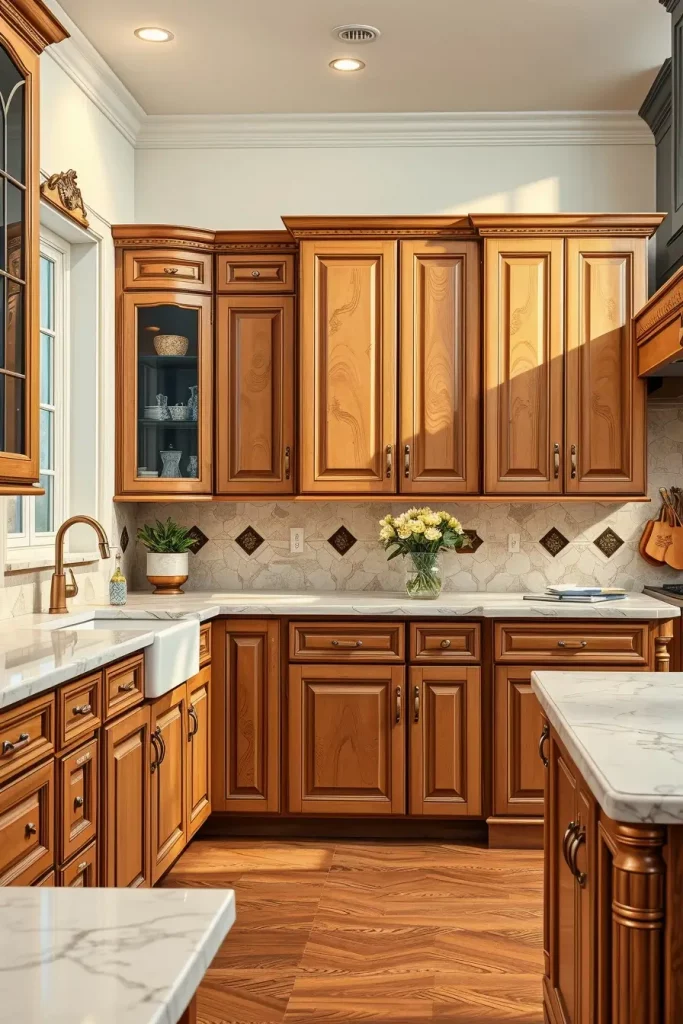
To sum up, this detailing gives it a made-to-order custom experience. House Beautiful mentioned that details like this give cabinetry a personal touch that I absolutely agree with when it comes to my clients who pay attention to small things.
Adding a glass insert or lighting over these areas would highlight these spaces and let people notice how they are made.
Raised Panel Cabinet Doors With Time-Honored Style
Raised panel cabinet doors are some of the features most linked with traditional kitchen design. They are both attractive, built to last, and can be adapted in many types of wood and coats.
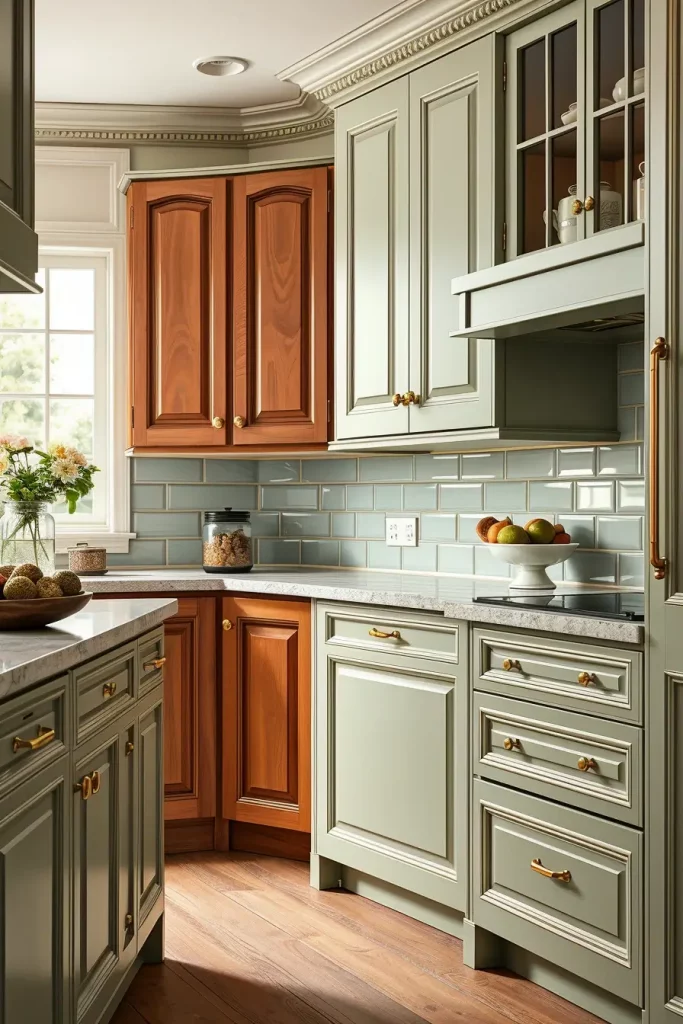
Many times, I suggest using cherry or quarter-sawn oak raised panels to show the natural grain. The edges around the profiles may be simple bevels or they could have decorative rope trim or elegant cathedral arches, depending on the kitchen’s design. It also looks nice when the paneling is painted in cream, sage, or navy while still seeming traditional.

You will always find raised panels in interior fashion. They are particularly important for kitchens trying to keep their history while adding improved features such as soft-close cabinet hinges.
Next, I would describe ways to use glass fronts or lattice designs on the doors in storage areas for spices and dishes.
Stained Oak Accents That Bring Out Warmth
The warm and rich look of oak is not always found in painted oak. Thanks to its natural beauty, I like to place oak in key areas such as shelves, walls, or culinary hoods to make the room look softer.
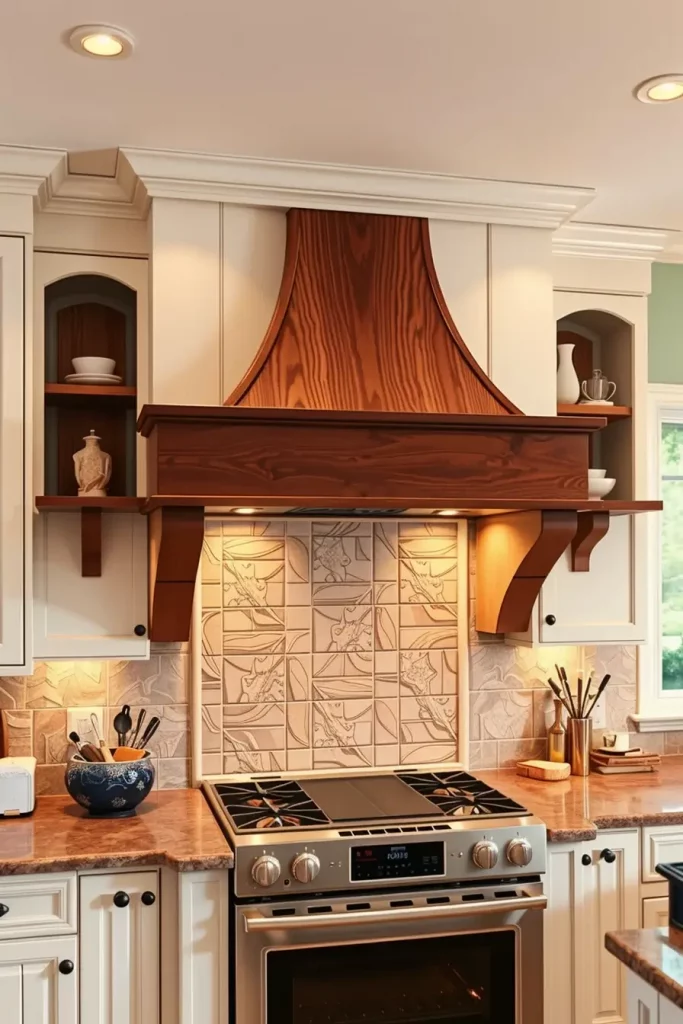
Depending on the amount of contrast you like, I prefer using golden honey, chestnut, or espresso colors. Oak combined with light cabinets gives the kitchen a harmonious and partially textured look. Since oak is hard and versatile, it performs well in kitchens used by lots of people each day.

From my experience, an oak wood finish brings a welcoming and solid look to a kitchen. According to articles by Elle Decor, more people are picking oak for its ability to contrast with modernized traditional styles. This seems like a bond that links past and present.
often there is not enough support added, for example, with oak corbels or trim across open shelves to tie together the entire appearance of cabinetry and countertops.
Walnut Countertops With Rustic Refinement
Using a walnut countertop is one of the most worthwhile things I’ve brought into traditional kitchens. The elegant touch and beautiful pattern in the tone make the room seem calming and luxurious when matched with lighter cabinets. Because of their warmth, they make any kitchen feel cozier and offer a nicer choice than stone countertops.
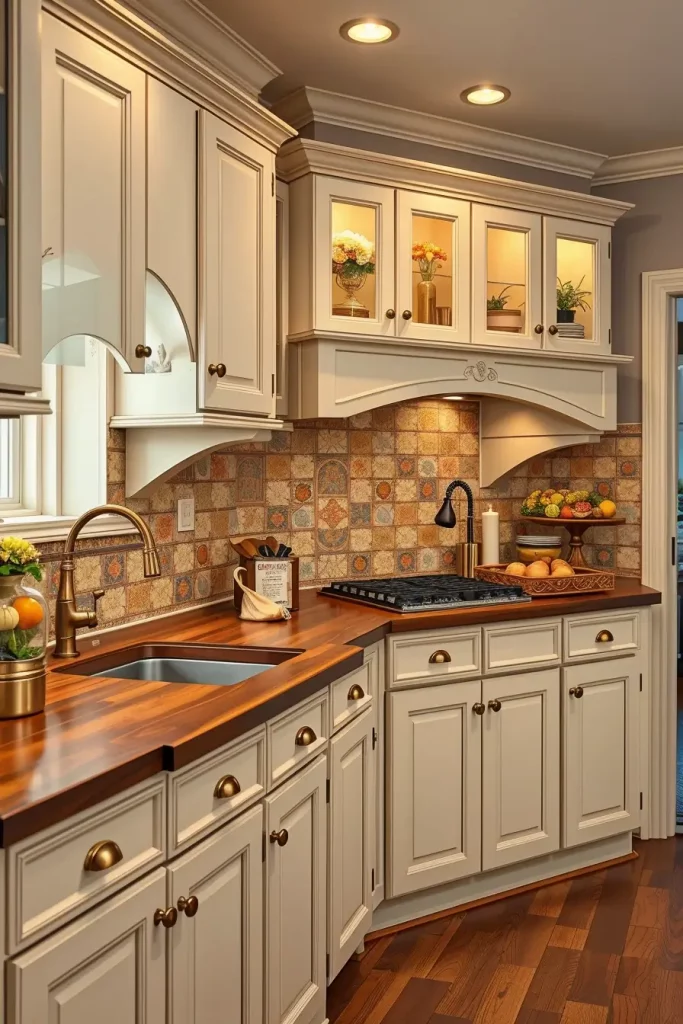
For my projects, I usually pick edge-grain walnut because it combines strength and a beautiful appearance. A worktop adds beauty as well as usefulness whether it is in the center or seen around the perimeter. With a clear oil finish, the grain of the wood can be easily seen and the wood still repels moisture to a certain extent. you might consider equipping drawers or shelves under the counter to keep the rustic look and increase the usefulness of the area.
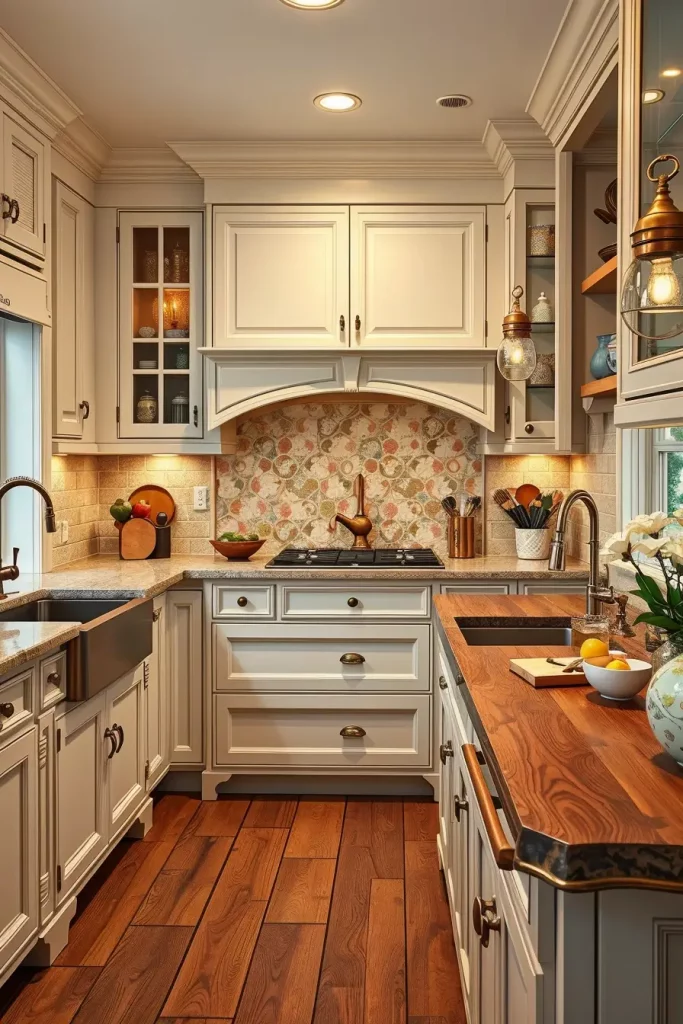
Walnut counters go very well with traditional kitchen styles. Walnut brings a classic look similar to antique furniture, as pointed out by Dwell Magazine, and that’s the exact effect I want for my clients every day. It looks better and more charming as time passes.
The area would be more attractive if walnut was teamed with aged brass lights or old ceramic backsplashes.
Maple Shelves That Showcase Simplicity
Maple shelves are great for clients who like to have their things out in the open while sticking to traditional design. White oak and ash can help brighten rooms that are mainly made of wood. Displaying old dishes or copper pots is best when they’re in these types of shelves since they add to the overall look instead of making the room seem crowded.

My usual suggestion is to use maple floating shelves that are either natural or bleached. Thanks to the strict lines and calm colors, the area feels both open and neat. Because maple is so tough, it can be left on surfaces all the time and looks good when set against white shiplap or a stone backsplash.

My favorite thing about maple shelves is that they prompt me to properly design a space. Most of the time, you notice mainly things that have been made with care, like recipes, handmade bowls, or glass jars. Real Simple magazine says that open shelving plays a dual role by looking elegant and being easy to use. I’ve discovered this fact in a large number of homes.
Moreover, making sure the lights are along the back of the shelf will make both the contents and the natural grain shine, especially in dim evening settings in kitchens.
Soft-Close Drawers With Handcrafted Dovetails
Even though soft-close drawers are a new idea, mixing them with handcrafted joints shows how they help merge the past with the present. These two are essential in any kitchen that looks nice and functions well.

I usually tell people to choose drawers made out of strong hardwoods, such as maple or birch, which also have visible dovetail connectors at the edges. Since they move without noise and close softly, these drawers are very helpful for families who like to eat late or have a lot of activity at home. Because the joinery is visible, the cabinetry gets a unique craftsman-like appearance rarely seen in pre-made cabinets.

Personally, I feel that it is where skills in making furniture meet our everyday needs. Even Fine Woodworking Magazine rates the dovetail highly for how strong and beautiful it is. These things set customized kitchens up for success over others.
In my opinion, these drawers seem particularly stunning when paired with antique-like brass or bronze handles, since it highlights the craftwork.
Distressed Pine Finishes For Lived-In Charm
Having a room with distressed pine gives it a very warm and familiar feeling. It shows the signs of aging, whether from the past or simulated, and gives any kitchen a historical feel. I managed to develop a farmhouse look for the space without it seeming cliché.

I like working with yellow pine that has gone through light sanding, scraping, or planing to show its unique features. Used for cabinet facings, cupboard doors, or walls of any division, it looks spotless. The texture stays the same, while the unique glow of the wood is not removed by this method. Giving iron handles or antique bin pulls a brass finish could create an old-fashioned look.
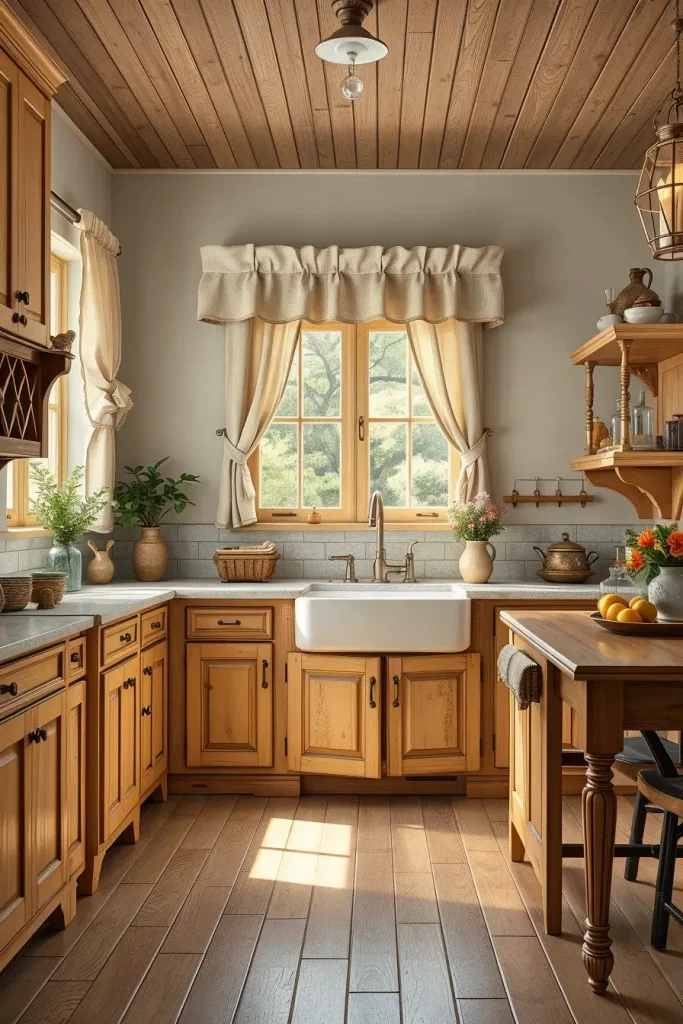
It’s clear to me that clients calm down as soon as they enter a space with distressed pine. This religion isn’t about being perfect, it accepts everyone’s imperfections. According to Country Living, distressed wood seems cozy to people who don’t want their home to be too sterile.
Let’s complete the feel of the room with comfortable linen curtains and a warm rag rug.
Cherry Wood Cabinets That Radiate Richness
Cherry wood kitchen cabinets have a royal feeling to them. Because of its gentle color and neat look, this wood is often chosen for traditional high-end kitchens. I pick cherry as the paint color when I want a room to have an earthy but elegant mood.
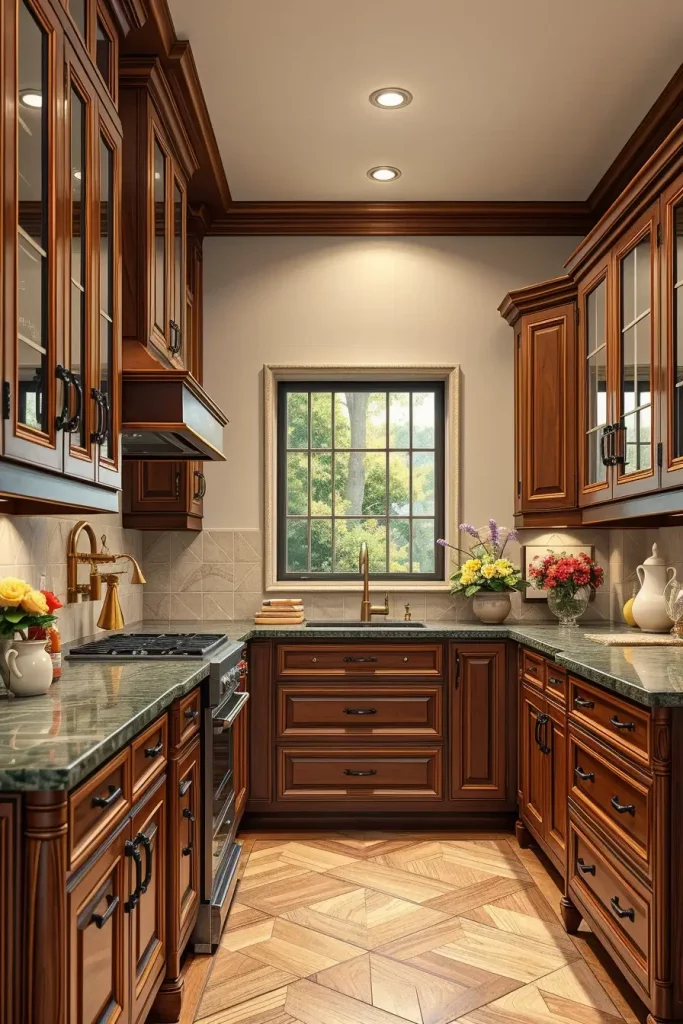
Most of the time, I choose full-overlay cherry cabinets that have raised panels and have a soft-satin finish. With time, the cherry develops a deeper patina that features and defines its character. Together with black granite or green marble, the warmth of the wood is really intensified in these cabinets.
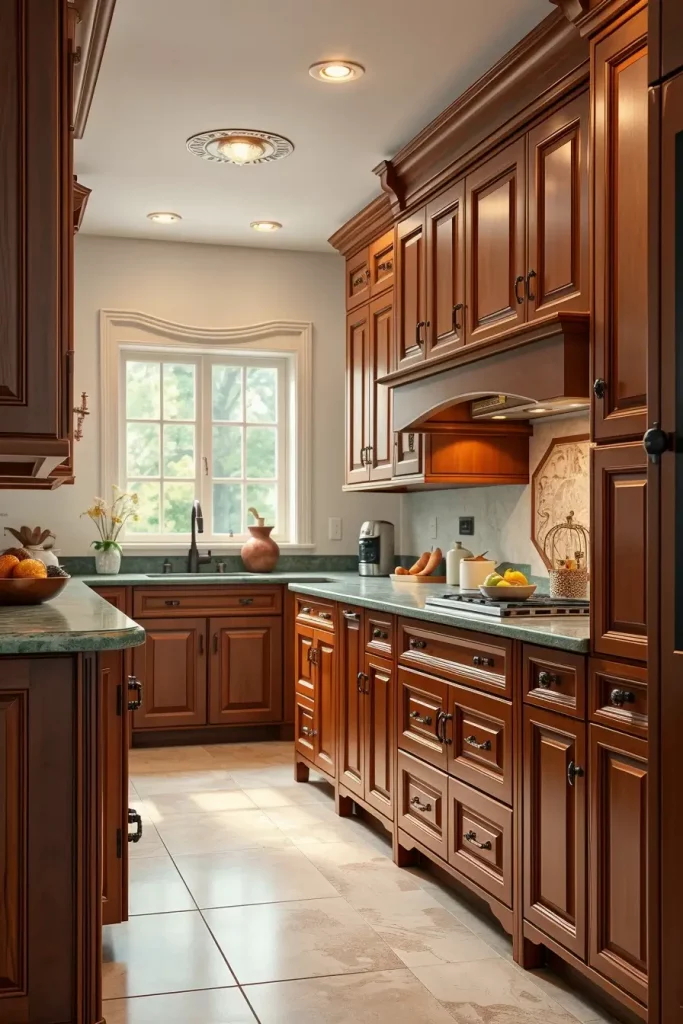
A lot of clients mention that cherries in the cupboards appear like something that’s been there for ages. Traditional Home highlight cherry kitchens in colonial and Georgian home styles, since they have many benefits. It is a type of wood that has many things to say.
Applying crown molding, fluted columns, or furniture in the same pretty cherry would add unity to the cabinets and make them stand out even more.
Built-In Hutches With Glass-Pane Elegance
A hutch that is built in can make any kitchen look like a classic dining room. Display, storage, and a point of interest are all included in these features. I enjoy having them set in the corners of my kitchen or beside the windows to make them look like a natural feature in my house.
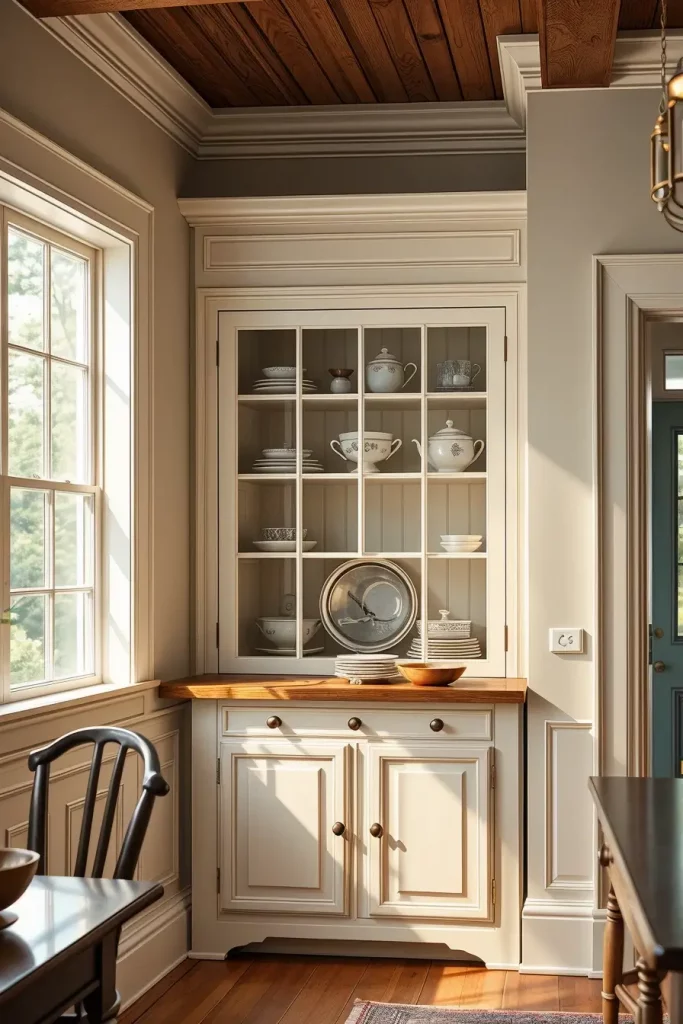
A glass-pane hutch, usually painted a light color like cream or blue and with inbuilt lights, is the one I prefer. I prefer to have crown molding and base cabinets so that I can store linen and party items inside. When joined with antique glass, the hutches look beautiful when lit by surrounding sources of light.

From my point of view, these hutches have a special atmosphere that’s hard to find elsewhere. They help the kitchen feel special, as if there are grand traditions and rituals happening in it. When I read that a hutch combines storage and what it means to us, I’ve recognized it to be the case with all my clients, as well.
One way to upgrade the section is by using leaded glass inserts or adding mullion windows so that it looks interesting and offers clear views out.
Wood Range Hoods As Carved Centerpieces
Having a wooden range hood gives the kitchen a wonderful way to show off traditional style. Its role includes being a main sculpture in the kitchen and also offering the opportunity to adjust tone, texture, and trim to suit your style.
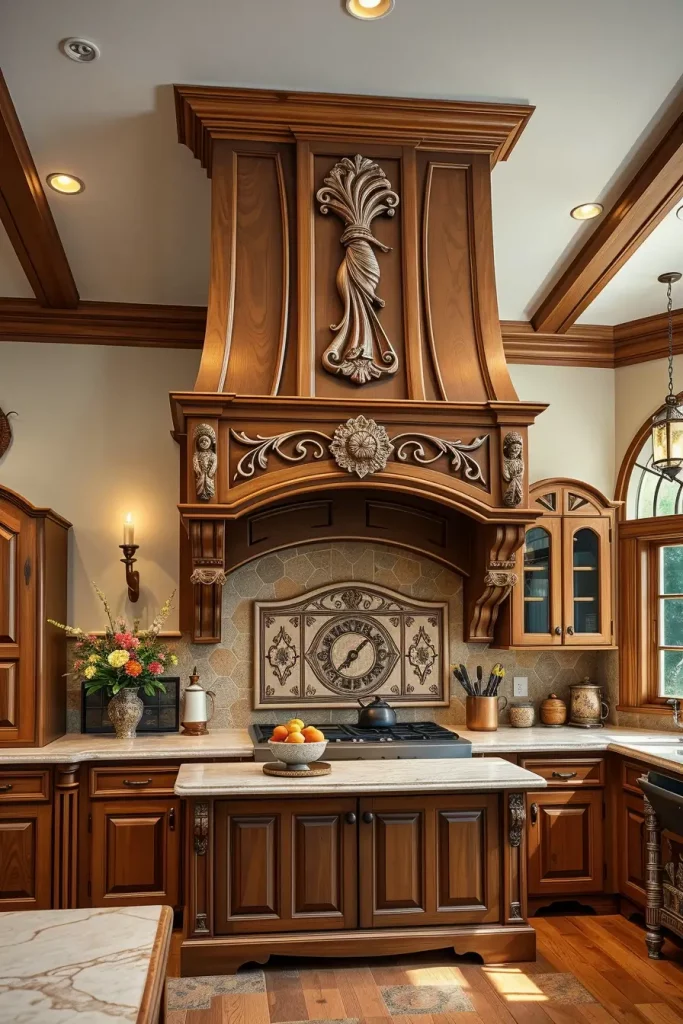
I usually pick oak, maple, or cherry as the base material based on the cabinetry’s design. A hood can have corbels, arched panels, or special carving that matches the cabinetry. I also recommend adding a metal insert liner inside to ensure proper ventilation while preserving the wood’s beauty.

I consider these hoods to be the best and most important kitchen appliance. They play an important part in the overall look of the architecture. The magazine Better Homes & Gardens states that a wood range hood plays an important role in determining the kitchen’s look, and I definitely share this opinion. It brings interest to the eye area and creates some drama without looking cluttered.
Very often, lighting is installed inside the cabinets or along the sides with sconces or artistic tile trim that both highlights the trim and the lighting.
Vertical Plank Backsplashes With Farmhouse Feel
Vertical plank backsplashes make the kitchen feel more spacious and at the same time give it a rustic farmhouse feel. If someone wants to create a mix of old and new styles, I usually recommend this choice. This kind of woodwork is not only aesthetically warm but also practical, as it’s easier to clean than traditional tile grout lines and can be treated for moisture resistance.
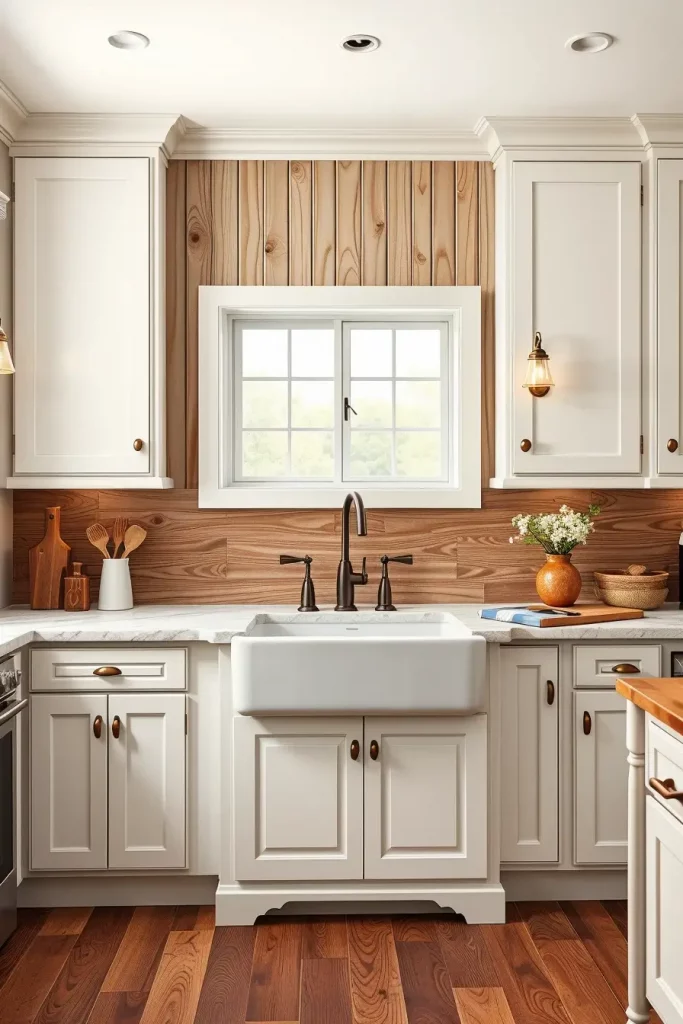
To make a vertical board, boards are usually created with strong wood like pine, maple, or reclaimed oak, painted in soft whites, creams, or left as they are for a rustic finish. A horizontal trim rail or cap at the top adds style to your backsplash at the same time as pleasantly framing the area. Farmhouse planks look right behind or along a coffee station, as they complete the kitchen with their pure style and appearance.
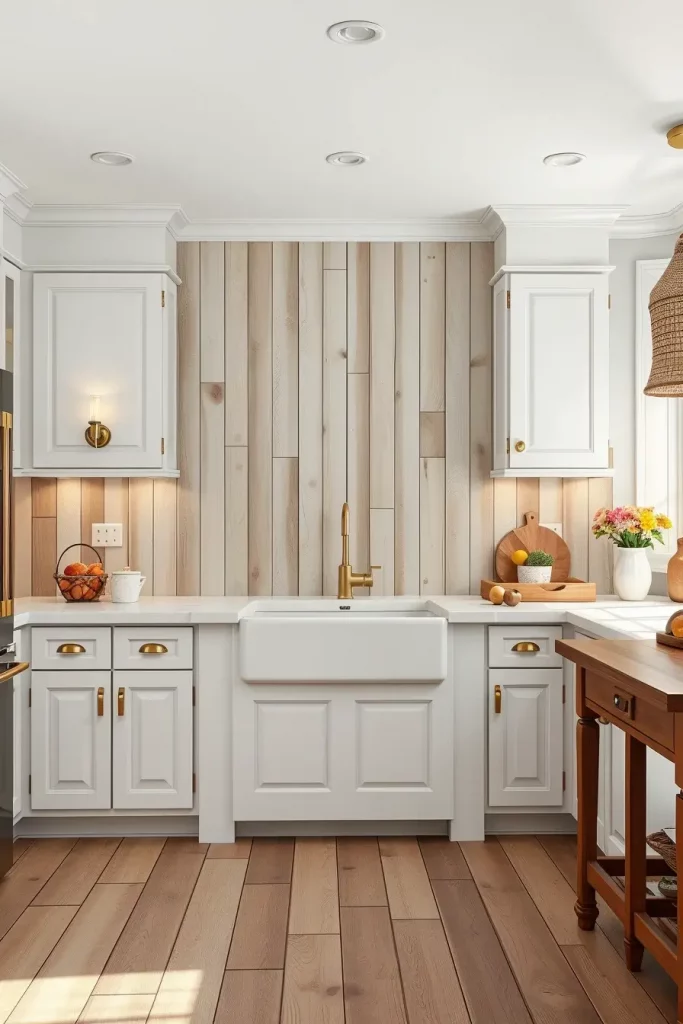
In my opinion, this aspect makes a space livelier but not too busy. I previously assisted a client in fitting this style in their little kitchen, and it improved the room’s cozy atmosphere right away. Manufacturing areas are said by HGTV designers to be elevated and styled nicely with vertical planks.
Here, adding sconce figlights in brass or matte black above the backsplash will highlight the tiles and make the kitchen appear soft and impressive during nights.
Decorative Corbels That Support History
Kitchens with woodwork often use decorative corbels as shelf or counter supports, but they are also very beautiful and decorative. I have often noticed in heritage kitchens that the carved supports gentle remind us of days when everything was made by hand. It’s fun to place them under overhead cabinets to let their design add some interest to the space.
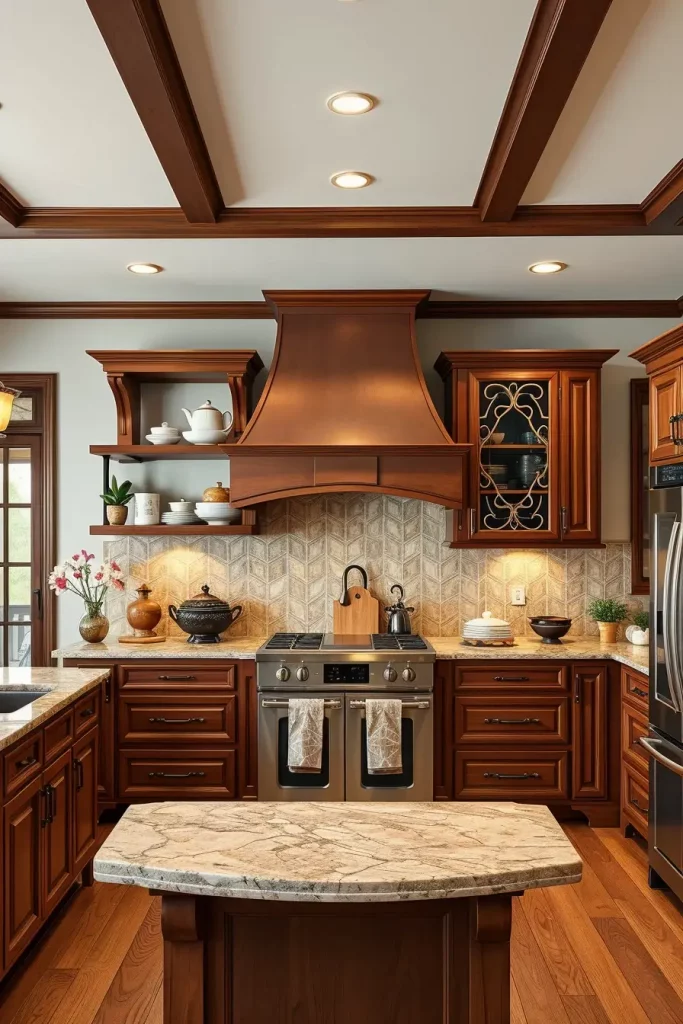
When made from cherry or walnut, these corbels have detailed carvings in the form of scrolls, acanthus leaves, and fluting. They seem to be ideal for use in classic or transitional kitchens, teamed up with finely detailed moldings and doors like those on traditional kitchen cabinets. If kept in their natural state or lightly damaged, wood beams create an authentic look that’s very hard to achieve nowadays.

Sometimes, I use old farmhouse corbels in my design projects. This process is fulfulling and gives your kitchen an interesting historical touch. According to Old House Journal, using corbels with glass-front cabinets allows you to mix practicality with style, and it is a strategy I always find works well.
To conclude this section, try adding crown molding that follows the same line as the cabinet’s edge. This way, the room feels finished and everything in it works together well.
Artisan-Made Spice Racks In Fine Joinery
Customized spice racks that are made with finely joined wood represent the essence of handmade kitchen items. Such options seem simple, yet they add convenience and skillful work at the same time. Most often, I plan them for those who really love cooking and want to have everything handy yet perfectly kept. You can use these racks by placing them inside your cabinet doors or having them as open shelves.
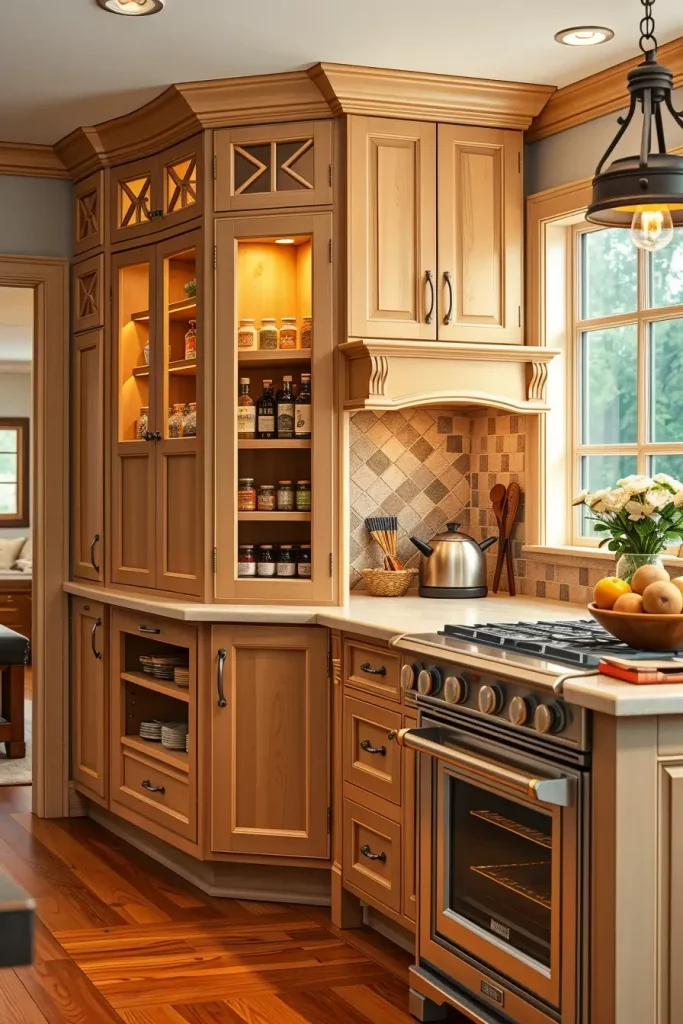
Normally, walnut, maple, or birch wood is used, making their construction look like a proper joinery project. Most times, I install a gentle rail or lip to prevent spice jars from slipping, and the finish looks however I prefer depending on how the rest of the kitchen is decorated. These racks add character, especially when they’re built into narrow pull-outs beside the stove.
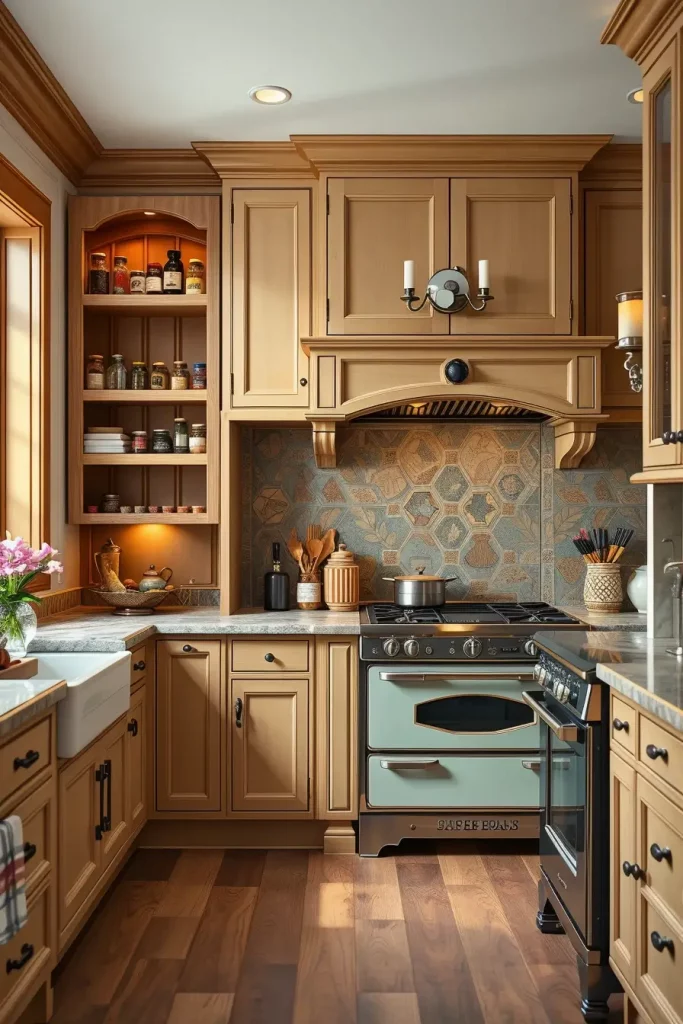
A customer of mine who loves cooking said that this greatly simplified her daily routine in the kitchen. In addition, House Beautiful writes that “simple wooden spice racks not only improve how things are stored but make the space feel classier,” which I have noticed to be true too.
Providing extra lighting below cabinets along the wall and using a marble backsplash next to the stove would make this space look even better.
Reclaimed Wood Cupboards With Soulful Stories
Having a kitchen made with reclaimed wood brings an extra emotional feeling to the space. It considers how sustainable, historic, and beloved old beauty is. If you wish for your kitchen to feel welcoming and used right away, try installing reclaimed wood cupboards. Because of their surface, smooth or imperfect, these cupboards usually stand out in the house.

If I have a choice, I usually pick reclaimed oak, chestnut, or barnwood wood. The common style is slab or shaker, and you can notice knots, nail marks, and faded finishes. I usually prefect my nails using a matte finish or natural oils to allow the textured nails to shine. The use of soft iron hardware or handmade ceramic knobs along with the cupboards brings an old-style look that mixes well with modern countertops and modern appliances.

Personally, I feel there’s nothing quite like opening a cabinet that once stood in a different home, a different century. Architectural Digest regularly features rustic-modern rooms with reclaimed wood cabinetry, and they like how warm and reliable it looks.
After that, I’d install soft LED lighting below the upper cabinets and could add an unfinished wooden border shelf that brings out the charm of the cupboards.
Soft Archways Framed In Solid Wood
Wooden soft arches help move from one cooking area to another in houses that have an open floor layout. People choose these when they would like to establish areas but without a solid wall. The arches are beautiful and keep the room open, as they direct your attention upwards.
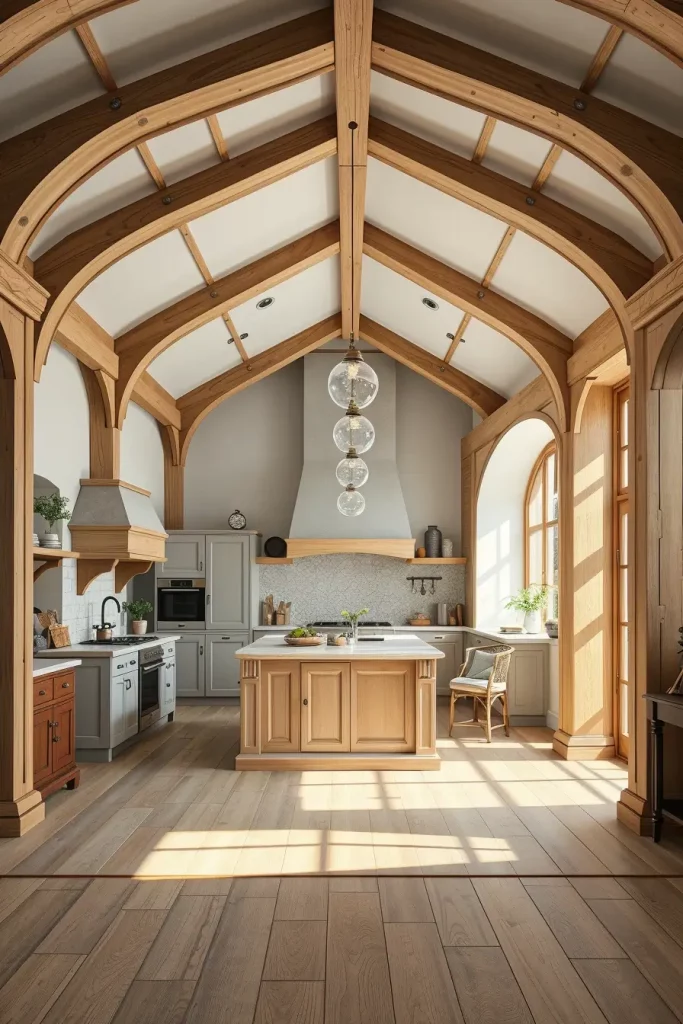
Buyers often get their frame made from white oak, alder, or ash, to create a finished look that is like their existing ceiling beams or cabinetry. For me, it looks best to use molding or tongue and groove within the arch as it enhances the curve and goes well with nearby woodwork. Having arched doorways between the kitchen and similar rooms helps unify the whole kitchen.
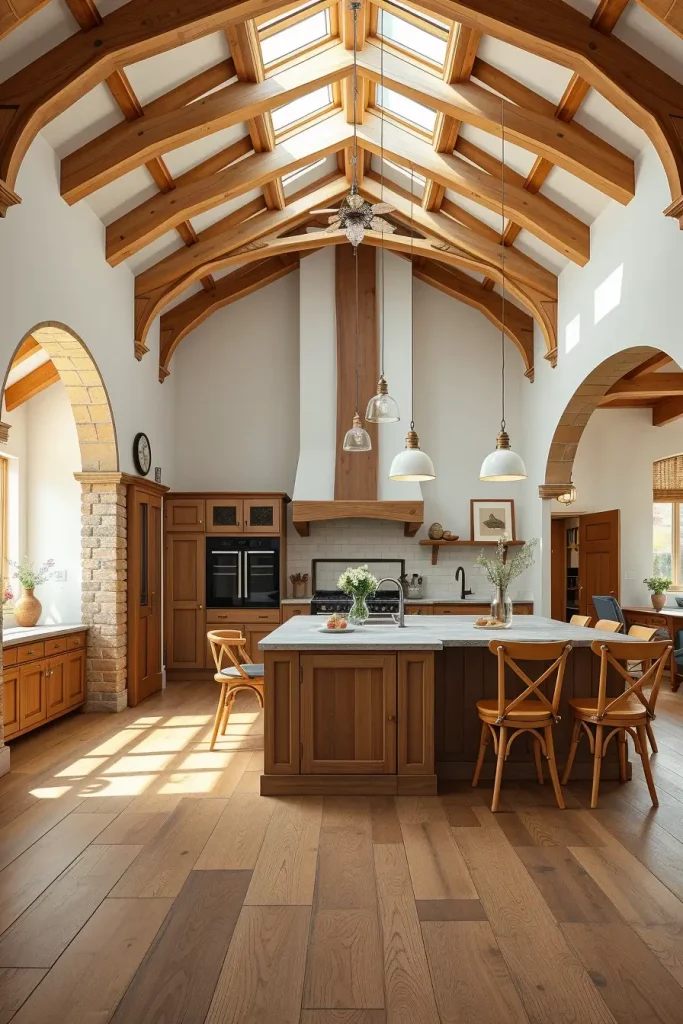
Lately, I assisted a family who wanted their kitchen to stay open but also have a main point of interest. The archway gave us the look of historical architecture made from natural wood. In many cases, This Old House recommends featuring arches to warm up modern looking details.
If I were changing this part, I would put pendant lights past the arch to give a clear border and slight lighting between the areas.
Turn-of-the-Century Trim That Adds Soul
People may not pay attention to it, but turn-of-the-century trim adds a lot of soul to a traditional kitchen. Putting in crown moldings, baseboards, or fluted casing may give you the feeling of millwork’s heyday. I believe that the best trim should reflect or recall the home’s original spirit or a past form of style respectfully.

In a kitchen, a millwork detail might be shown by the presence of deep crown molding under the ceiling, decorative rosettes above the windows, or pretty header panels over the doorways. The poplar or maple trims are painted to go with the cabinets, helping create a continuous flow in the room. I favor a flat look with eggshell shine, because it gently glows and stays true to the material used.
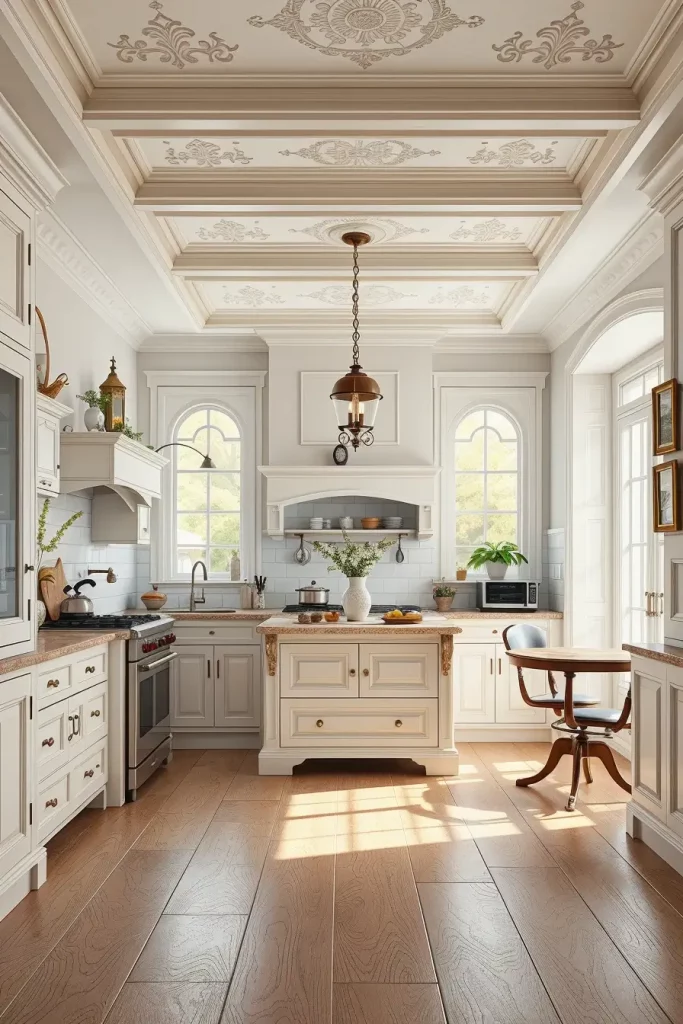
The original kitchen trim was a key aspect in reviving the design, since we gave it priority during our bungalow renovation. Better Homes & Gardens suggests that using a bit of traditional trim can enhance a kitchen and offer a strong point of focus. I’ve given that suggestion to many different clients.
My trimming process would wrap up by putting on painted vent covers that match seamlessly with the stools on each window.
Inlaid Butcher Blocks For Daily Rituals
Being more than just a surface, a butcher block acts as an important ritual area in your daily cooking tasks. I usually suggest placing butcher blocks on kitchen islands or near where preparing food takes place. Inlaid stone is fitted directly into the countertop, making it seem like a single unit and useful at the same time. Awesome design and sturdy, these sheets are attractive to anyone who loves wood.

Usually, I prefer maple end-grain because it’s both tough and kind to my knives. Having stones or solid materials around the inset area on a kitchen counter adds style and helps in daily cooking. Often, I will have a recessed area for juices, and on some edges, I put on a metal band for strength. What’s left is a setting that is strong, planned out, and suitable for any chef.
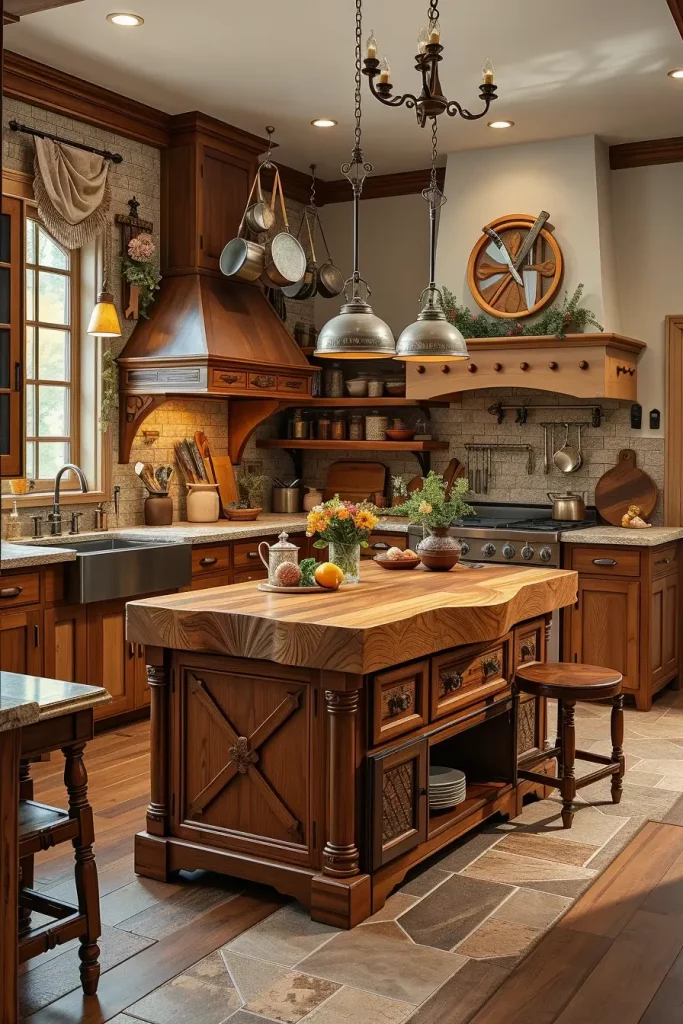
People at Fine Homebuilding consider butcher block inlays to be “functional focal points,” and I completely agree with this. Clients who love charcuterie or baking are always happy to gather their supplies on their boards.
Given that this area holds many things necessary for cooking, open shelving next to this space will ensure that needed items are fast to grab.
Wood-Framed Pantry Doors With Vintage Glass
A pantry is more than a storage space—it’s a statement of hospitality and tradition. Making the doors with natural wood and using glass from older windows creates a focal point out of any entry. I tend to offer this idea to people seeking a gentle form of elegance in functional locations. On account of the glass, interest is visible, and the wood frame contributes to its warmth and depth.
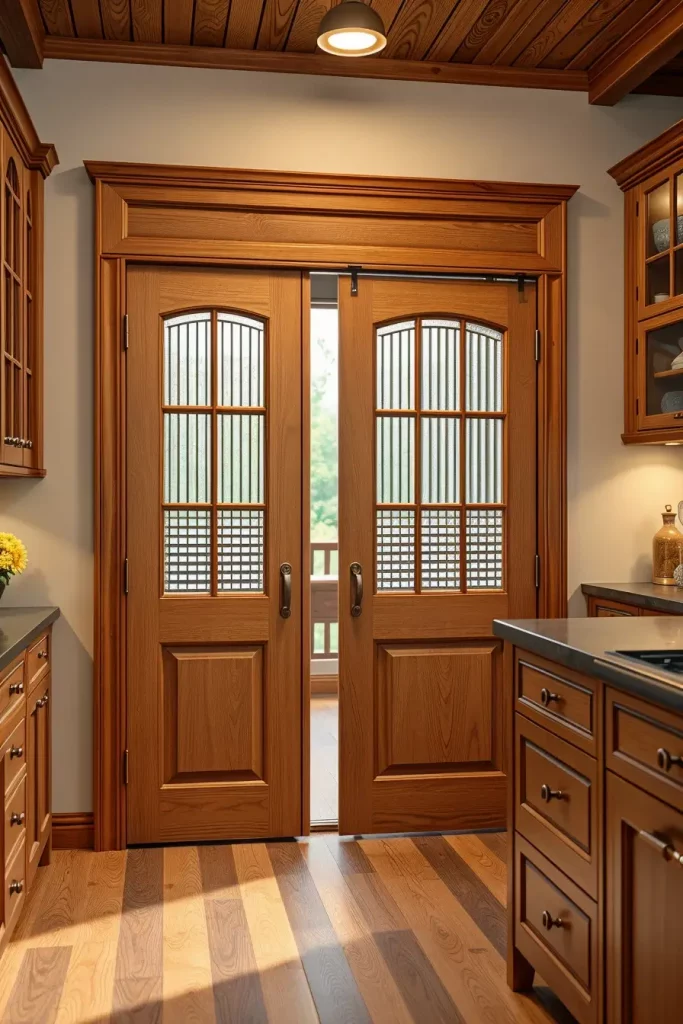
Normally, I suggest using quarter-sawn oak or alder for the door frame and finishing it with a warm stain that is similar to the cabinetry beside it. Ribbed, frosted, or seeded glass can be used to protect a person’s privacy but still reflect an old-fashioned style. You can use these doors for transitional or farmhouse kitchens and match them with wooden frames and either brass or matte black doorknobs.
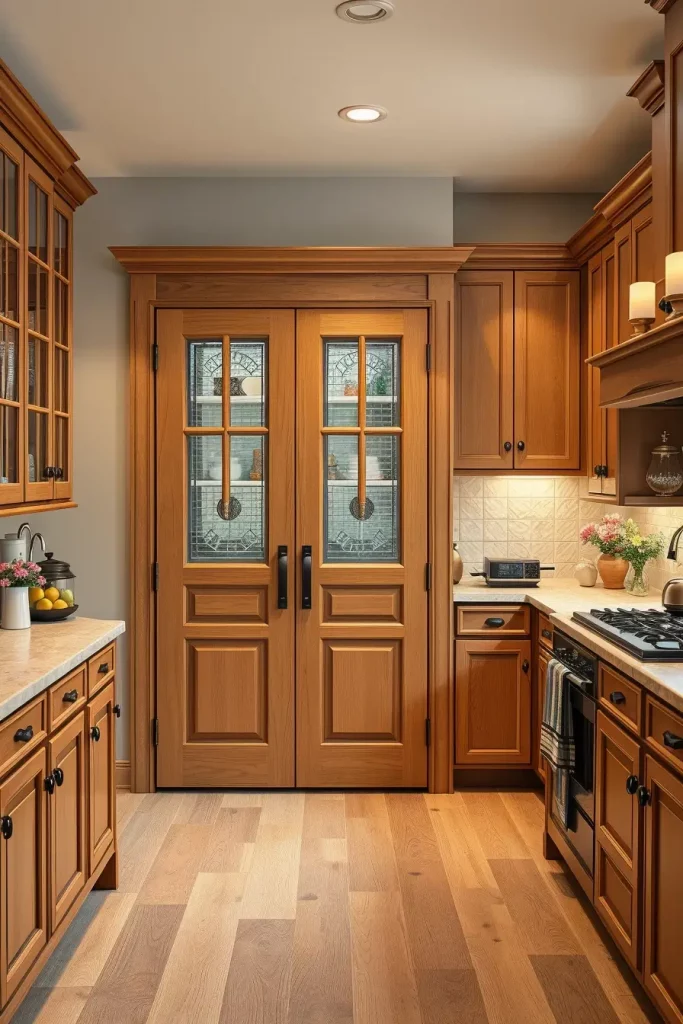
Personally, these doors give just the right level of elegance but not enough to be pretentious. A client recently decided to upgrade regular solid doors for the custom-framed ones, and I noticed right away how much better it looked. To quote Southern Living, the style supports its goal to be both traditional and practical, which is what I wish to give to my readers.
To complete this style, make sure the pantry looks similar to the rest of the room by placing millwork or a coffee station next to it.
Shaker-Style Cabinets That Celebrate Simplicity
Shaker-style cabinets have become an iconic feature of kitchens that last the test of time. Because of their basic, streamlined design, they can be a part of farmhouse, colonial, and minimal traditional spaces. Whenever homeowners ask for a sense of order, calmness, and design in their kitchen, I advise them to consider cabinets.
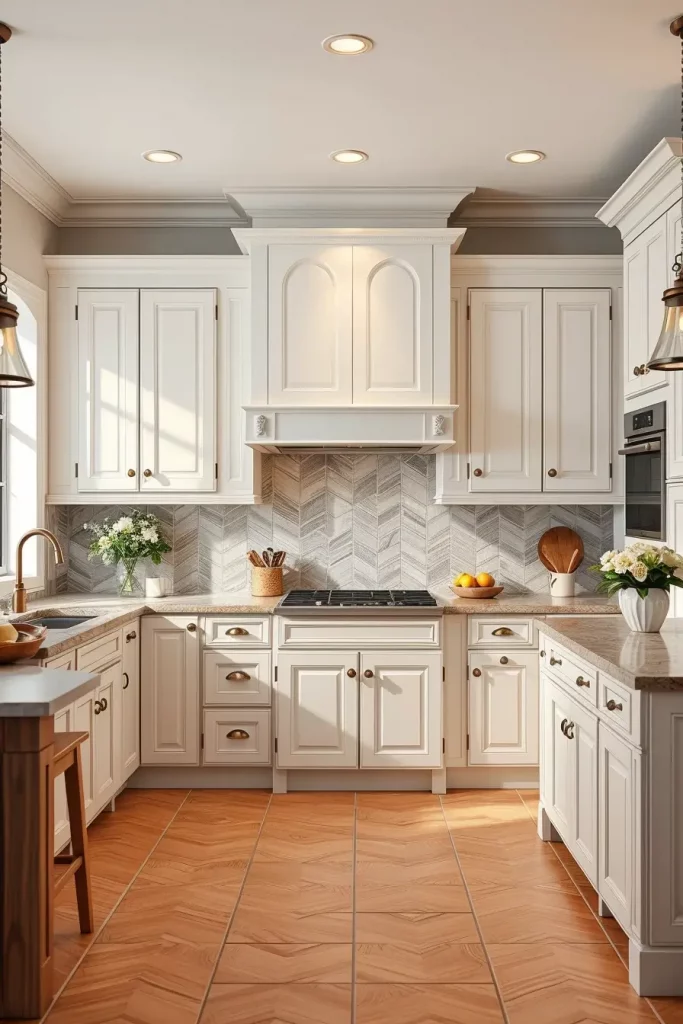
Usually, custom hardwood cabinets are painted or stained in white, gentle blue, or a natural way that lets through the wood’s grain. Since they are mainly built for use, I usually choose inset doors, concealed hinges, and wooden drawer boxes to match them. Austerity in design highlights both the other details, such as unique hardware, and the striking countertops.

Even though I have used my kitchen with shaker cabinets for many years, they still look strong and solid. Dozens of projects I’ve seen only confirm Better Homes & Gardens’ note that the style excels because of its strong focus on clean lines and straightforwardness.
If I want to enhance this area, I’d apply crown molding to the upper cabinets and possibly include a peg rail near them to link the functional beauty with other areas around it.
Decorative Wood Vent Covers With Custom Charm
Often, designers forget to add interest to the vent cover. Most kitchens use metal grilles that clash with the wood look throughout the kitchen. I advise using custom wood covers on the vents, as they provide a more suitable finish for kitchens that stick to tradition. It’s possible to have them painted to go with the cabinets or to have their finish stained to match the flooring.
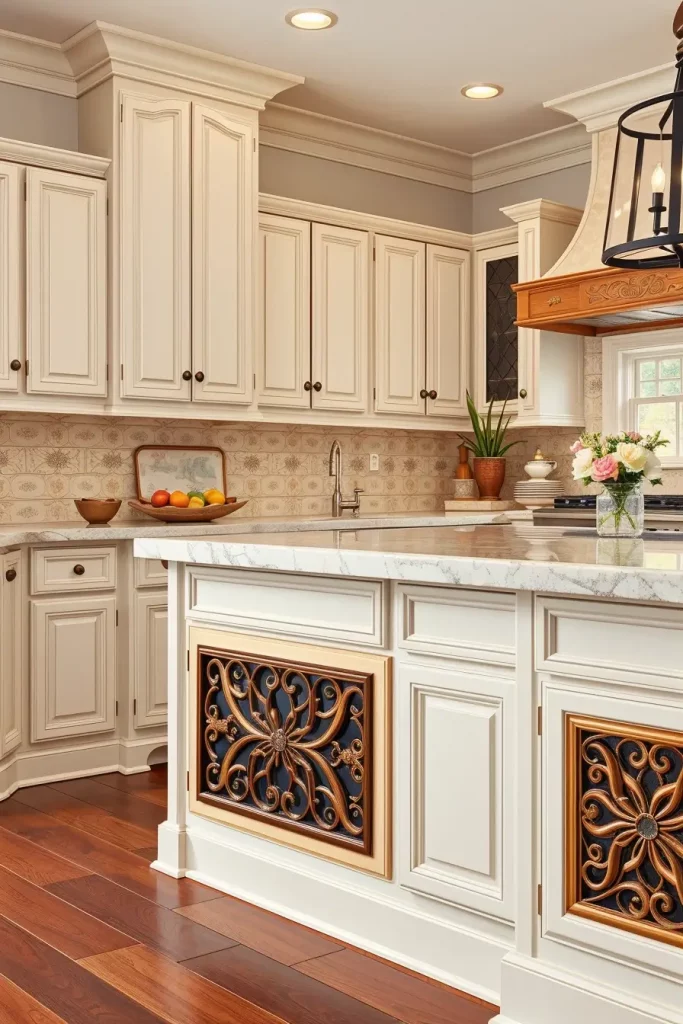
The covers are made by woodworkers using CNC machines or by skilled chiseling, and they usually work with maple or poplar because these stable types of wood offer the desired look. You can come across designs with lattice, floral, or geometric-type perforations. These things blend in perfectly with the room design when fitted discretely into cabinet footings or walls.
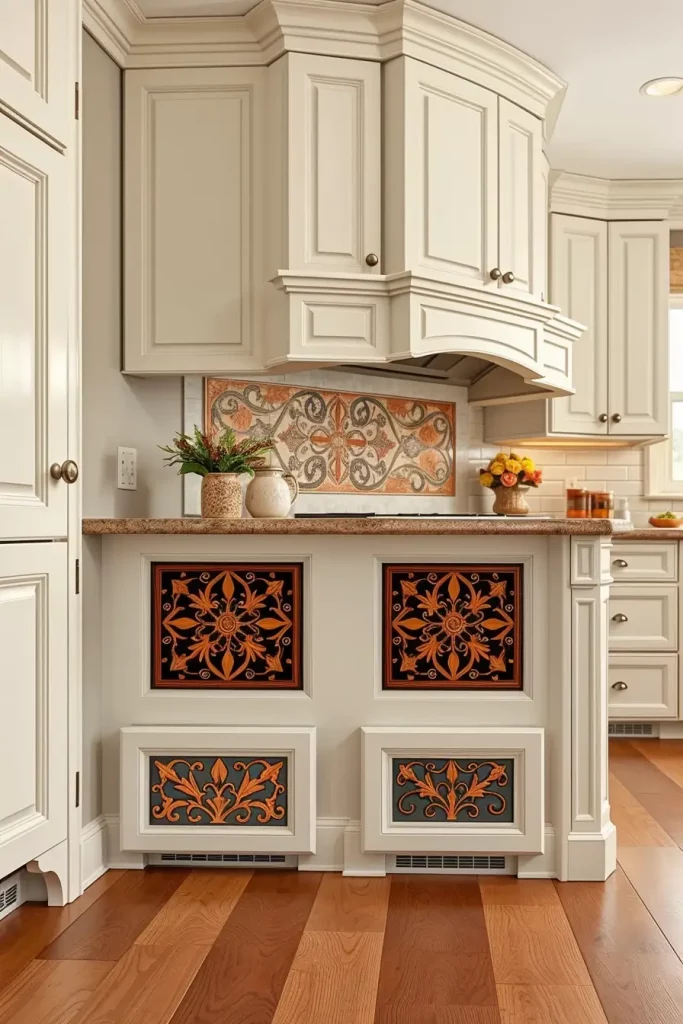
At that home, the client was glad to see how these minor changes made the kitchen more like a crafted piece of furniture. AVO provides custom vent covers, like Fine Woodworking says, for their “quiet but powerful” results in designing quality home indoor spaces.
For a complete look, I’d add matching switch plate covers and perhaps a wooden lighting trim to echo the same patterns throughout the room.
Peg Rails And Hanging Boards For Everyday Use
In its simplicity, the idea of peg rails and hanging boards still fits well into signs of modern kitchens. We usually insert them in backsplashes or sidewalls, as they come in handy for clients to hang their aprons and utensils on. They give you convenient storage that does not fill the room.
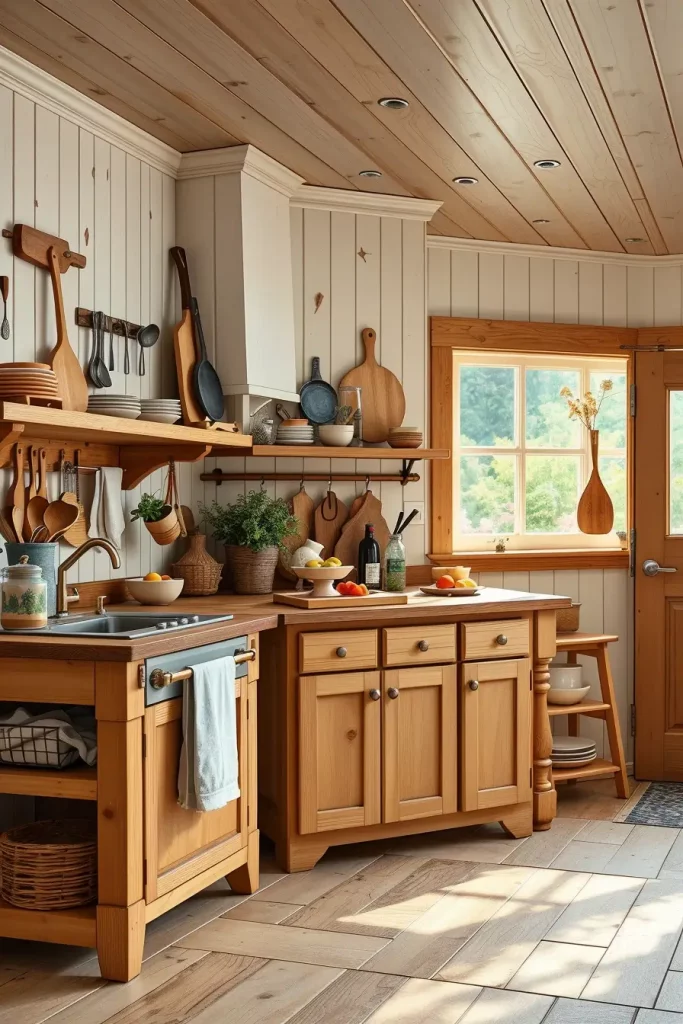
Most of the time, these rails are made from oak, beech, or pine, and they have equally spaced pegs; they may also come with a small shelf above. Waxing or oiling the wood helps it shine and I suggest leaving them close to food preparation areas or breakfast areas. Shaker cabinetry and paneling are made to complement Green Oak cabinets.

To me, it brings better organization and helps me get used to a daily routine. I remember a pair of young people who loved putting their everyday items up since it led to less clutter. According to House & Garden, a similarly designed peg rail is an economical touch that unites the regular routines in the kitchen.
For an even more cohesive feel, I’d suggest running the rail beneath a horizontal band of beadboard or matching paneling to integrate it visually into the kitchen’s architecture.
Wooden Drawer Inserts With Practical Beauty
Some woodwork is special even if people don’t see it firsthand. Very often, tucked away wooden drawer inserts help to both beautify and organize the storage in your kitchen. You should suggest them to clients who wish to pay attention to even the smallest details in their design. They help improve the organization of utensil drawers as well as spice bins.

Due to their construction with maple or walnut, together with dovetail joints or close routing, these inserts can be changed to accommodate tools for silverware, knives, or wine bottle storing. I choose units with detachable movable shelves and a felt cushion on bottom for opening in silence. They look great with strong wood drawers and standard cabinetry.
There was one kitchen where the client called their insert the highlight of the room, since it was just the right size and location for them. There is often a mention in Dwell of how thoughtful and visually appealing custom drawers are in kitchen builds for the wealthy.
To enhance this zone, I’d suggest also considering soft-close slides and integrated lighting for deep drawers—elements that complement the craftsmanship of the insert itself.
Beaded Wood Paneling For Classic Ambiance
Beaded wood paneling adds rhythm and softness to a kitchen’s vertical surfaces. Often, I suggest using this option on islands, around the oven, or in every part of a breakfast nook to make the room feel cozier and more traditional. Such lighting makes sure to add shadow lines that give the space more beauty and excitement, but not too much.
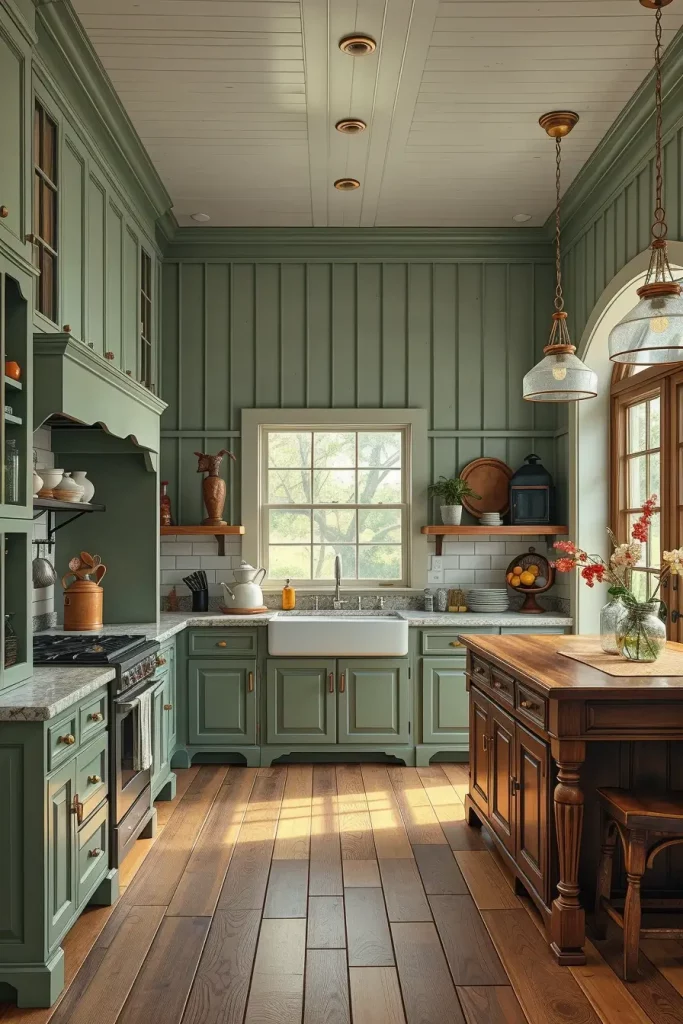
The boards are most often made from pine or poplar, are narrow and each has a bead in the center of those links. Using them in a pale white or toned sage hue is my preference, and I tend to suggest architectural tiles be paired with painted shaker cabinets or wood butcher countertops. Solar panels can be put up on walls or roofs, whichever suits the dimensions of the room.
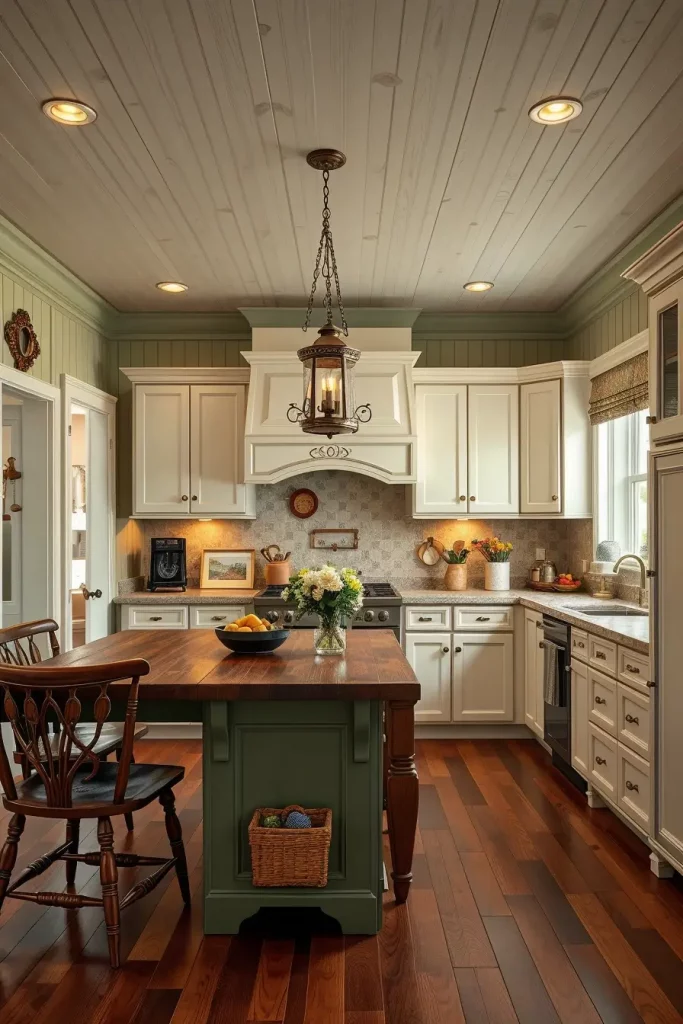
I’ve used beaded paneling in both large and small kitchens, and the effect is consistently warm and charming. Country Living states it should “bring a sense of cozy charm to every room,” which is clearly what I want as well.
It could help to add a wooden bench painted in-situ and a set of shiny brass wall hooks, as these details make the traditional story stand out.
Cabinet Toe Kicks With Custom Scrollwork
An area most people wouldn’t look at for artistry is the toe kick in the kitchen. I like to use scrollwork cutouts that seem to add lacework to your cabinets. It brings a touch of class, so that even basic cabinets can stand out.
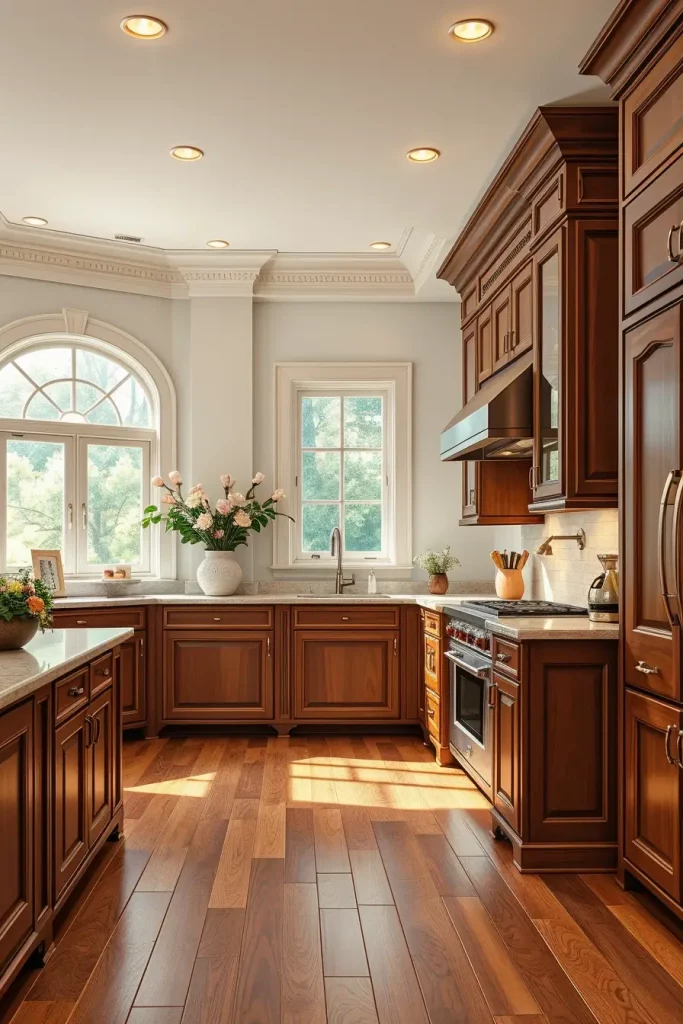
I have noticed that people either hand-cut or machine-milled these scrolls from maple or cherry and then paint or stain them to coordinate with the cabinets. A look can be formed as a wave pattern, a package shape, or a traditional rococo design. I prefer putting ads in places below sinks or prep areas since people tend to look there.
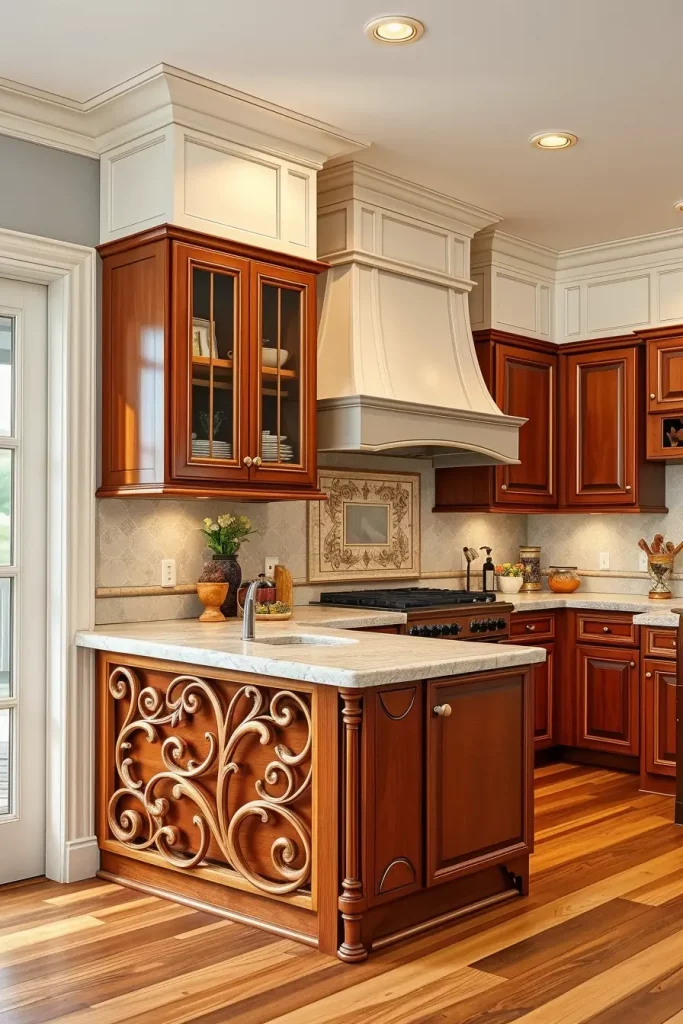
A homeowner once said about it: “It was as if I had found trim for my favorite dress.” It comes across as intentional and close to the director’s heart. Recently, Old House Online included such details as scrollwork in its recommendations to “bring traditional crafts into daily parts of home decor.”
Another tip would be to put a valance above the sink or stovetop to reflect the shape of the toe kick for a unified look.
Ladder-Style Open Shelves In Polished Cherry
When I see open shelving with a ladder style as soon as I enter the kitchen, there’s an instant effect of being clear and beautiful. Thanks to these shelves, the kitchen receives an impressive, long line that serves for both storing and displaying items. Such a design fits smaller spaces perfectly, as it draws the attention up and allows you to use every inch of the wall.

All shelves are made of cherry wood and polished softly, so their warm, reddish color stands out. The vertical design gives a lovely visual appearance to a kitchen, whether it is classic or transitional. I like to position the shelves far enough apart so there is room for different items, giving your shelves both an appealing look and natural storage. Brackets or supports in wrought iron or aged brass make the shelf look more old-fashioned and substantial.
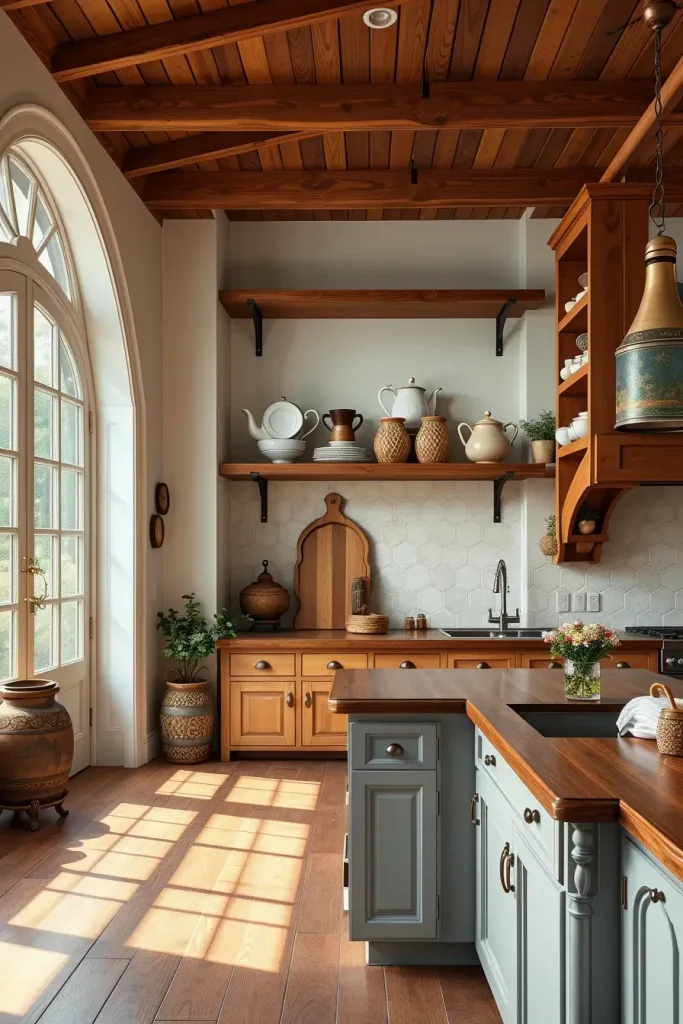
To me, this style balances well the seriousness of classical music and joy of lighter pieces. Having a clean and uncomplicated design but adding a creative touch is what farmhouse interiors offer. I’ve noticed that Better Homes & Gardens has featured similar designs that people enjoy for saving money on upper cabinets and improving the room’s style.
You might also add under-cabinet lighting and integrated slots for storing wine glasses so that both the aesthetic and practical sides of your minimal design are boosted without being changed.
Hand-Sanded Wood Finishes That Glow Naturally
In most kitchens these days, the surfaces tend to look and feel made with synthetic elements. For this reason, I often go back to admiring the looks of hand-sanded wood finishes. Because of the way they’re made, these pieces tempt you to touch them and get to know the character. Whether you use a butcher-block island or cabinet fronts with a frame, this way of finishing makes your kitchen stand out since it cannot be achieved by machines alone.
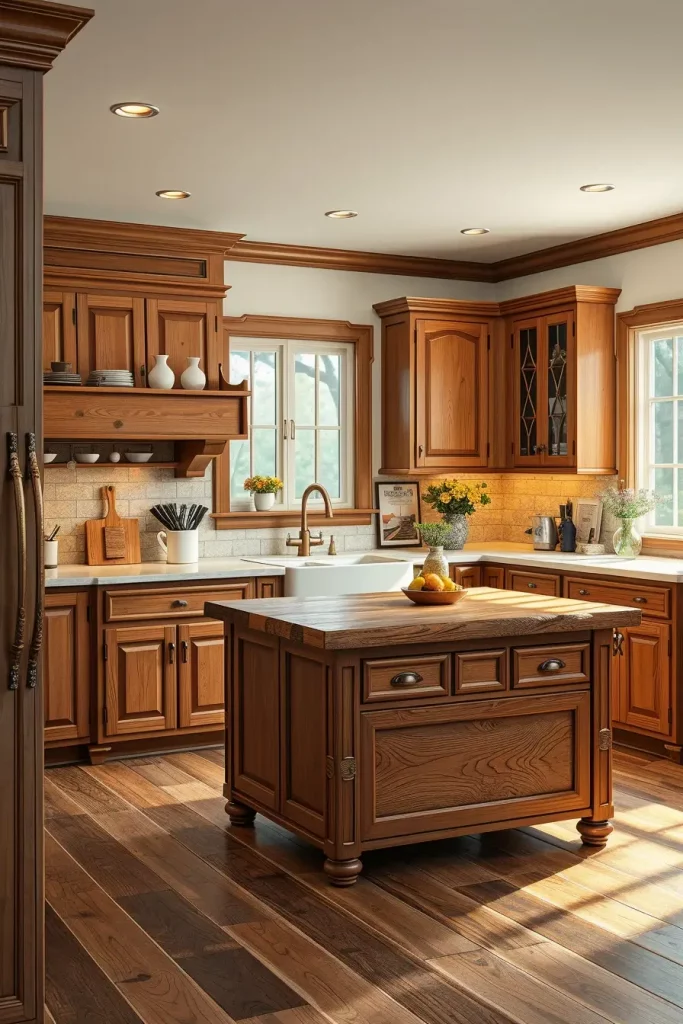
Usually, my choices for this design are maple, birch, or reclaimed oak. When you finish with sanding, oil or beeswax will reveal all the character in the wood’s grain. A touchable surface adds a lot of appeal to a kitchen. Frequently, I use either leather pulls or aged bronze knobs on them for a classic style.

I decided to use the method mentioned here on my old countertop, and it made a big difference in my kitchen. Dancing gives me a sense of belongings since it is soothing and steady. A chef’s kitchen featured in House Beautiful was done in walnut that was hand-sanded, giving a soothing elegance that nothing lacquered could offer.
Make the look more sophisticated by including softly rounded corners on countertops and drawer fronts—this additional touch can improve the end result.
Built-In Seating Benches With Carved Backs
A seating bench in the breakfast nook offers comfort and style, plus carving the back gives it an even stronger artistic touch. It is nice to place these benches by a bank of windows so sunlight filters over them in the morning. It looks good in farmhouse-style and craftsman-style kitchens, making it perfect for homes that require smart ways to use space.
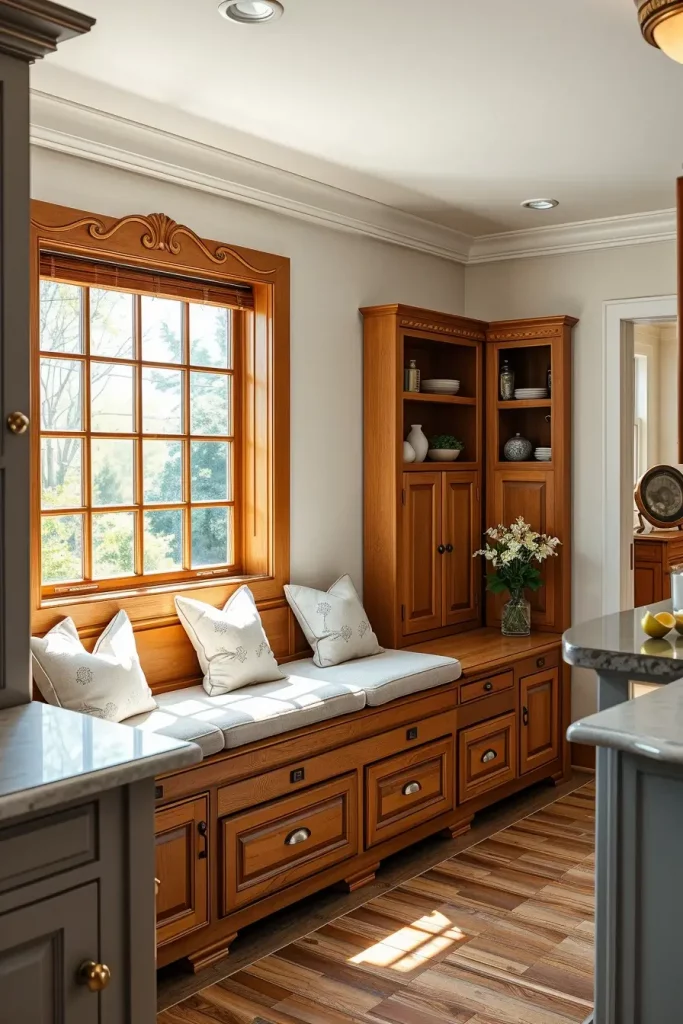
I choose to use quarter-sawn oak or knotty pine for this design, and usually finish it with a natural look or warm earthy paint. The curved and carved backrests are where regional designs from all kinds appear, including floral, folk, or Celtic motifs. Natural linen or ticking stripe cushions enhance the look, and the roomy drawers below the seats hide extra linens and different kitchen tools.
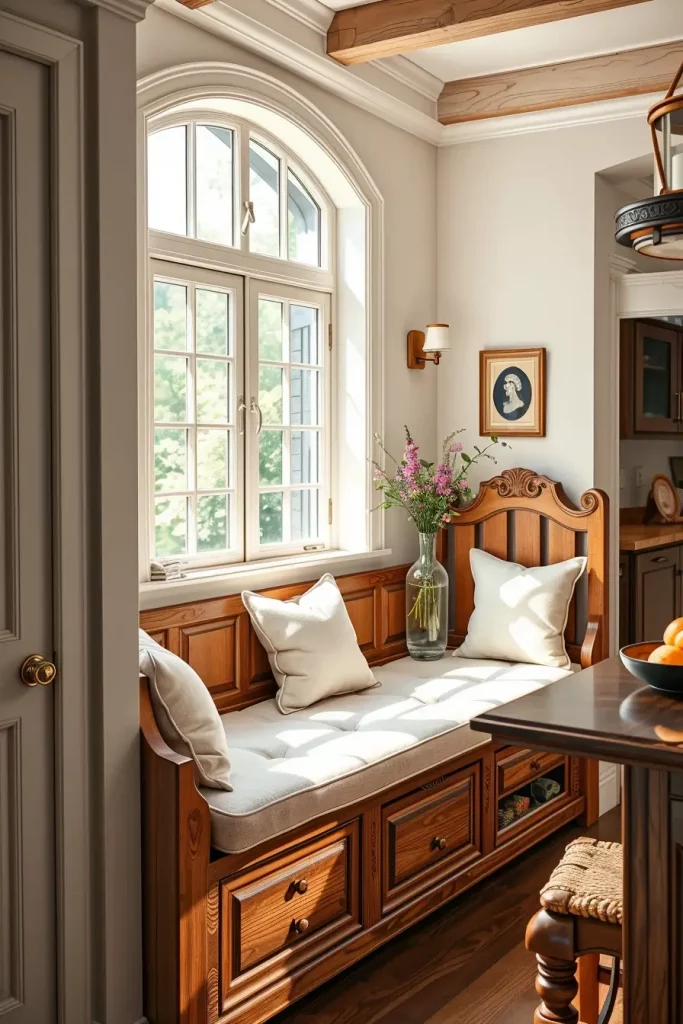
From my experience, putting in benches under my dining nooks usually makes a family-friendly spot instantly. As once mentioned by This Old House, “Advance planning – including a space for an island – directs the look and feel of the kitchen.” Not matter if you are hosting people or helping with schoolwork, they become more than an empty seat—they help you feel at home.
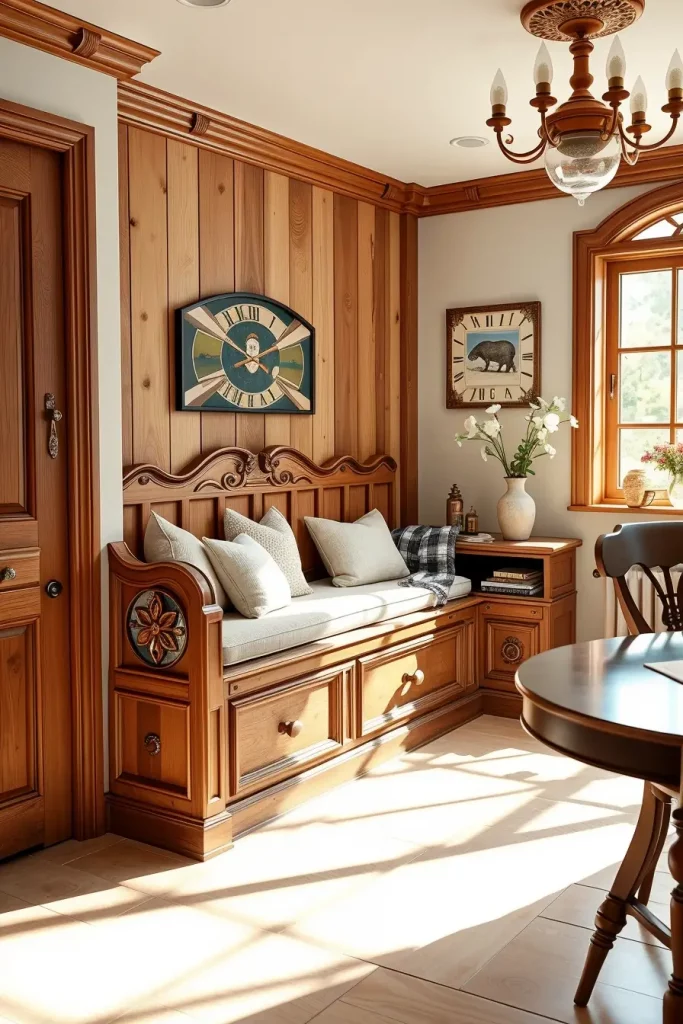
What is missing from this idea? Wall sconces at each end of the bench help blend it with a side table built from the same wooden material.
Legacy Woodworking That Ties Generations Together
Using legacy woodworking methods means adopting a certain way of thinking. When furniture or other woodwork in the kitchen is connection to the past through a grandparent’s home or family barn, it adds emotional connection to the room. This technique really moves me, and it makes designing kitchens for such honoring situations very worthwhile.
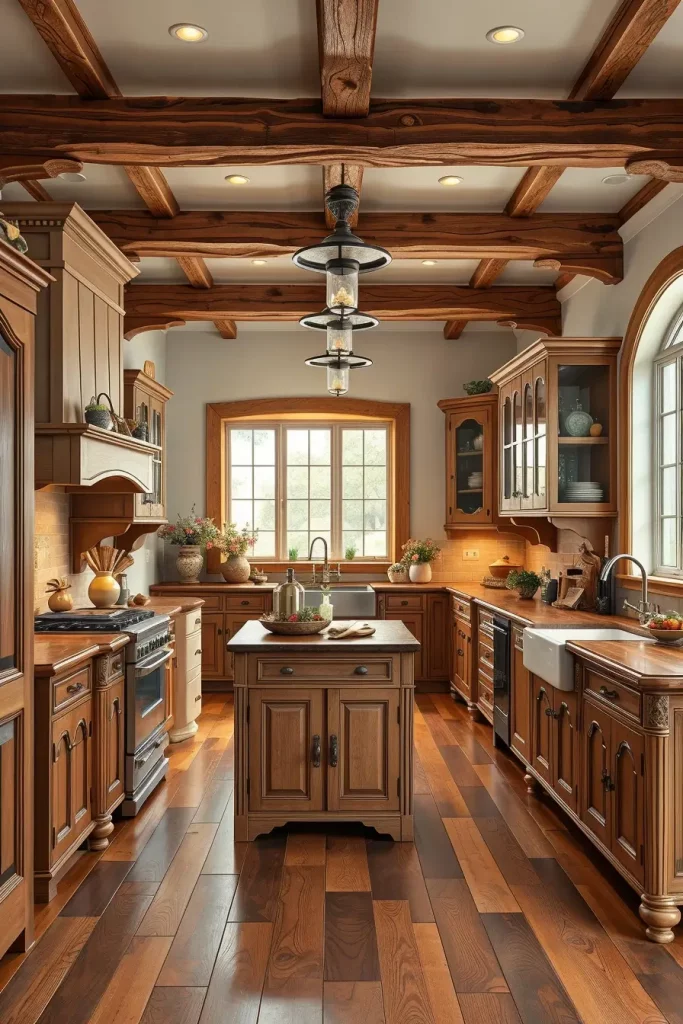
My clients have also picked out designs where they added family names, personal symbols, or old pieces of carved wood to their cabinetry or islands. Just one touch like a baked-orange corbel or a breadboard used for shelves may be enough to invite heritage into your room. I recommend using pieces from the past that coordinate with new things in the room so the spaces features both history and a current look.
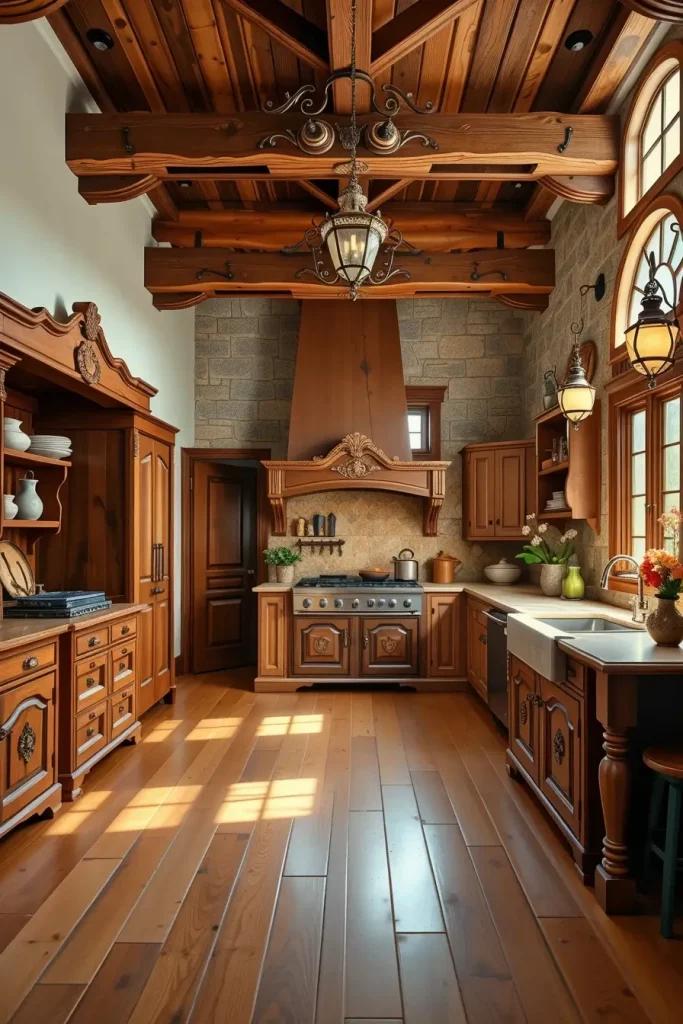
As I was restoring my aunt’s house, we used her father’s hand-made cabinet doors to create a new pantry wall. Remembering a shared time can happen every time we pass by them together. Such publications frequently point out that good kitchens are not only neat, but also used and loved by the whole family.
Those who are new to this process should begin with little steps. Purchasing just one piece of used kitchen wood can form the foundation for a family’s gradually growing vintage kitchen collection.
Whether in their designs or finishes, these traditional kitchen woodwork show that quality craftsmanship lasts forever. Whether you’re drawn to the charm of ladder-style shelves or the soul in legacy woodworking, there’s something here to stir your creativity and heart. Which idea had the most impact on you? Feel free to comment and tell us how you enjoy spreading warmth and tradition in your kitchen.
